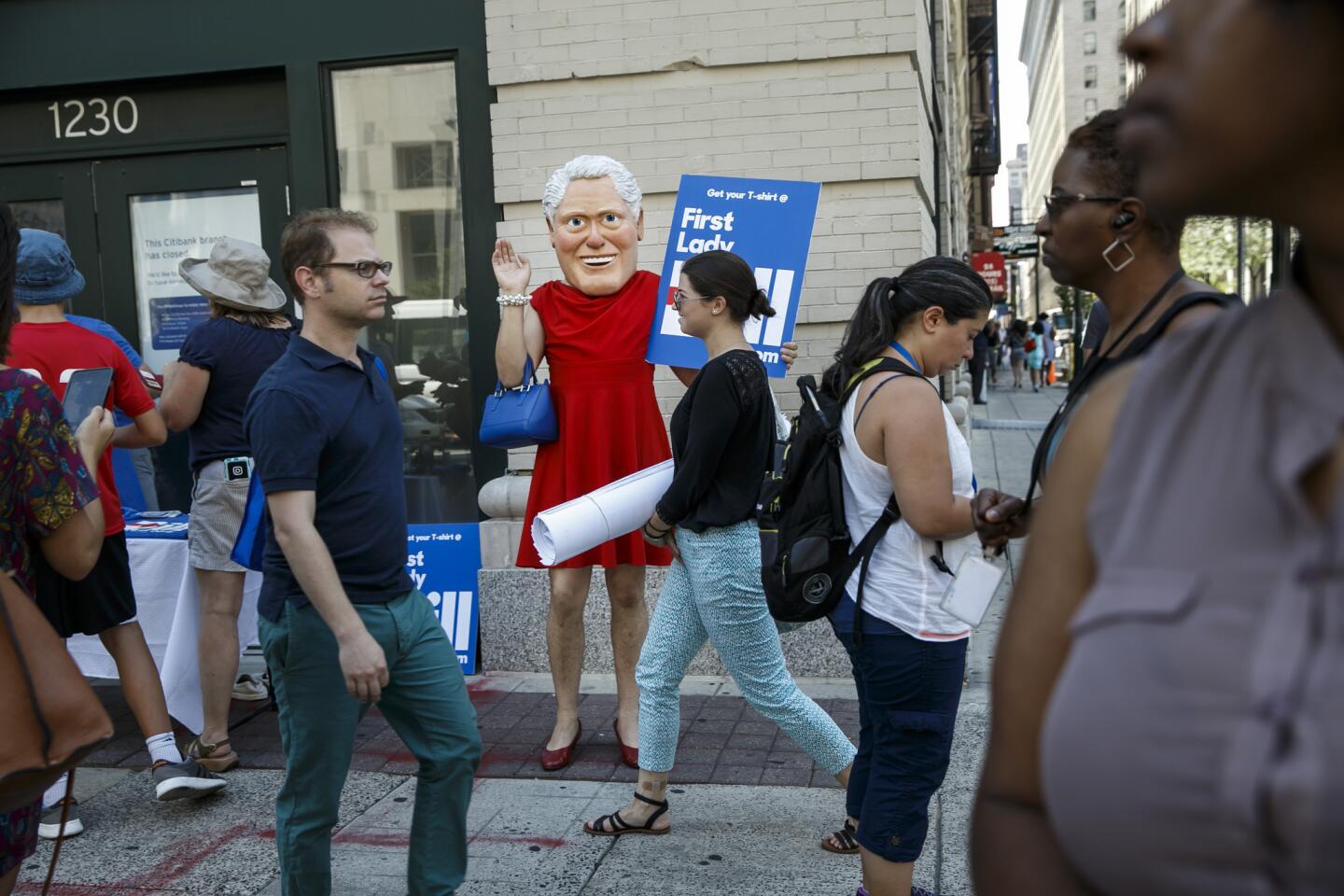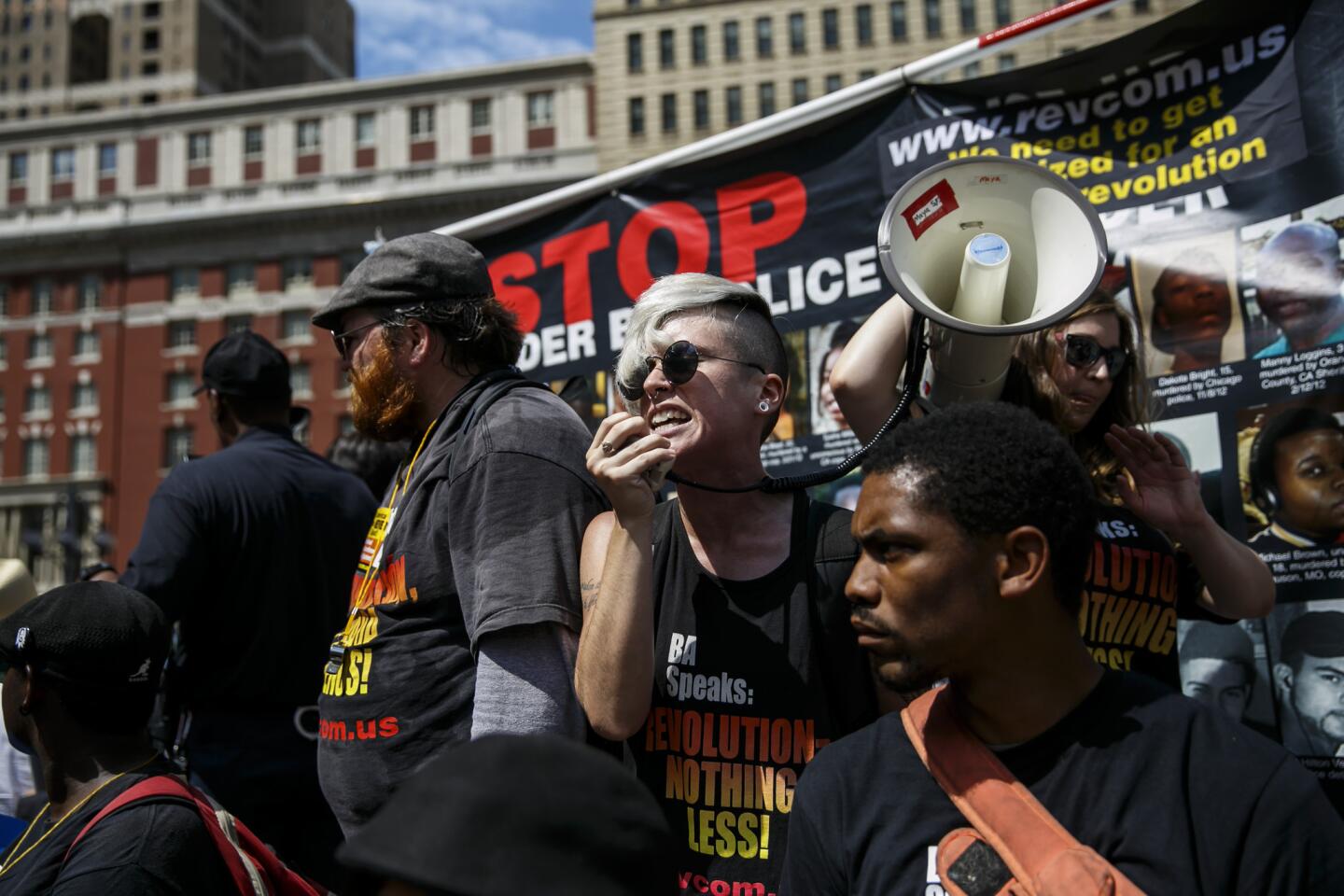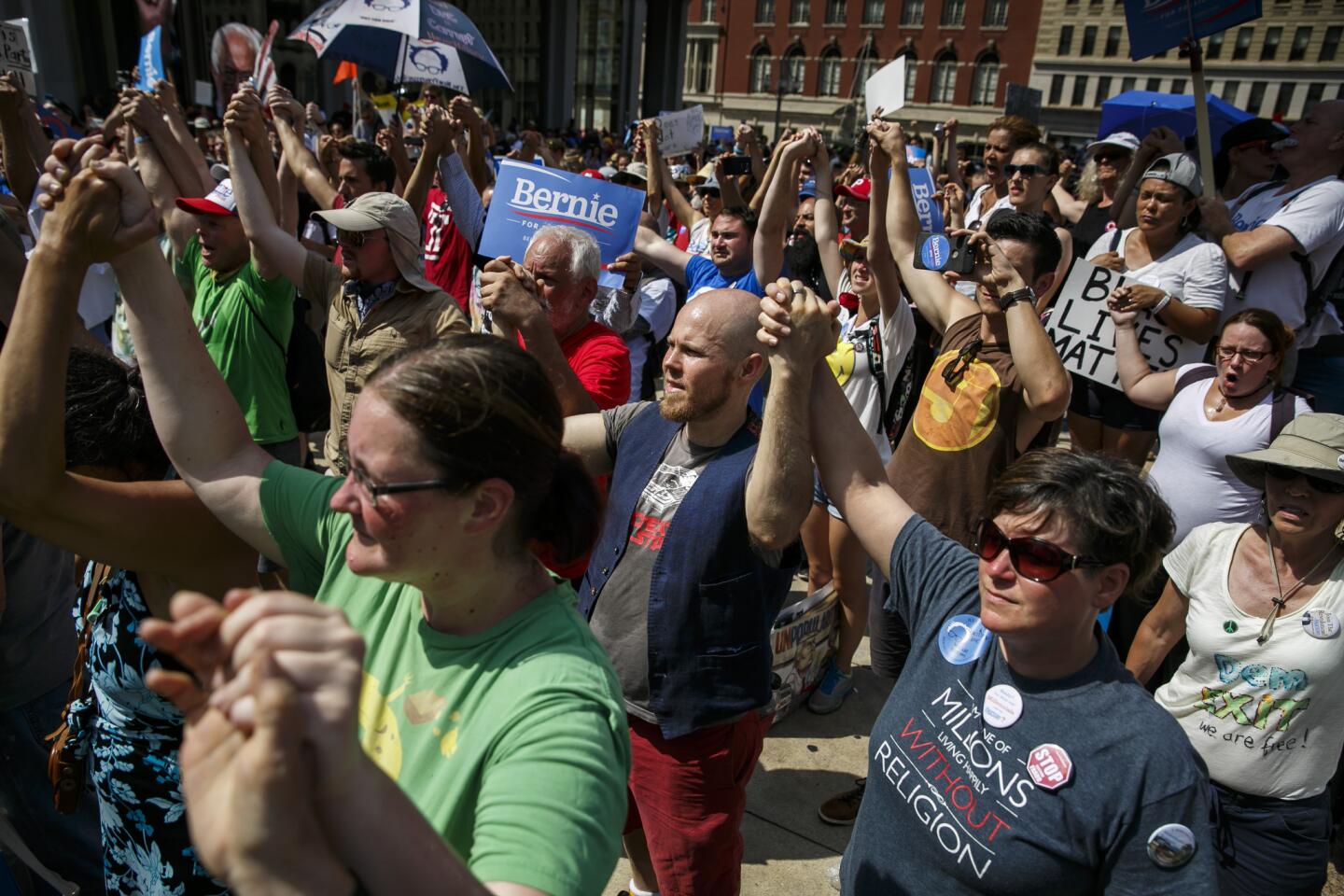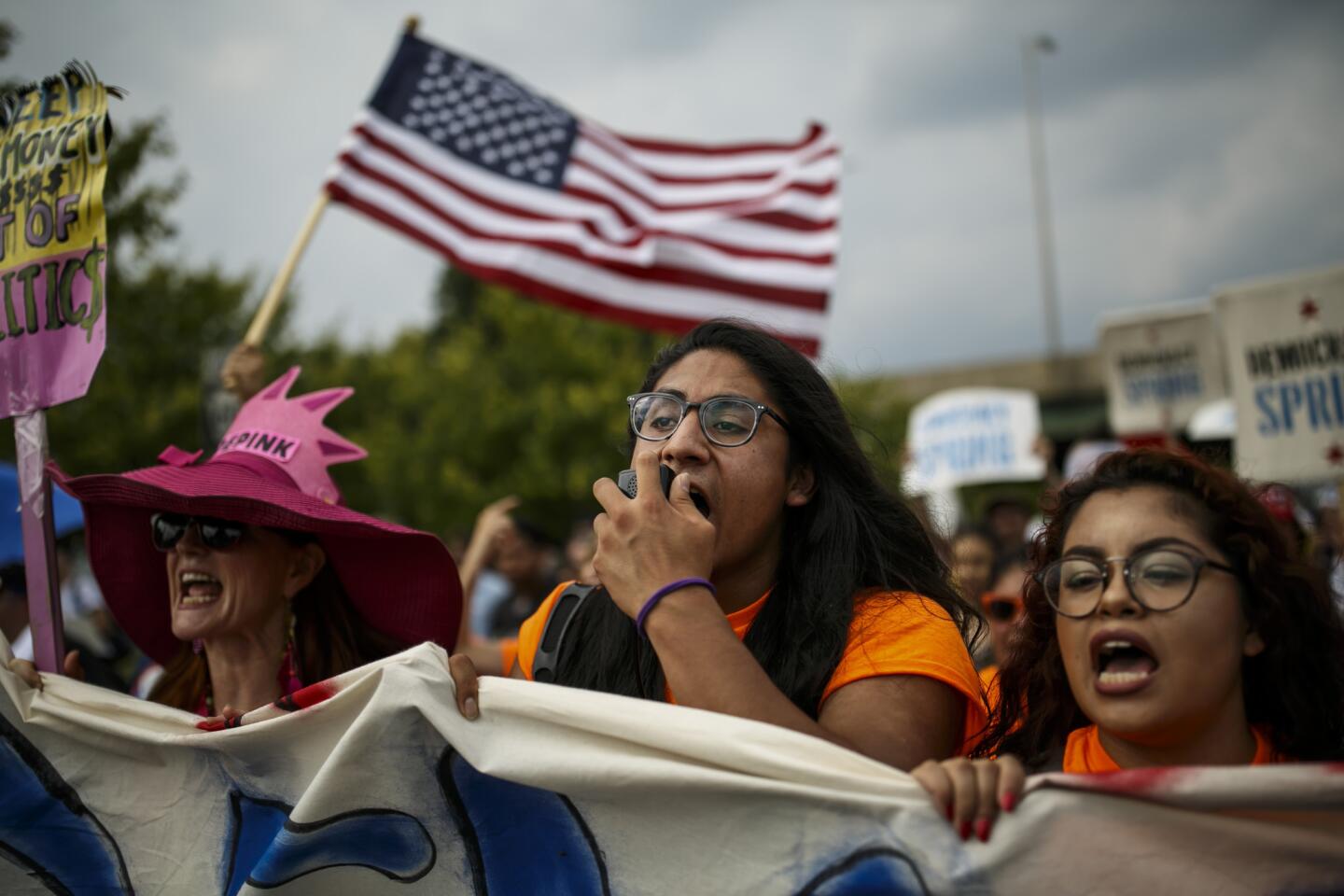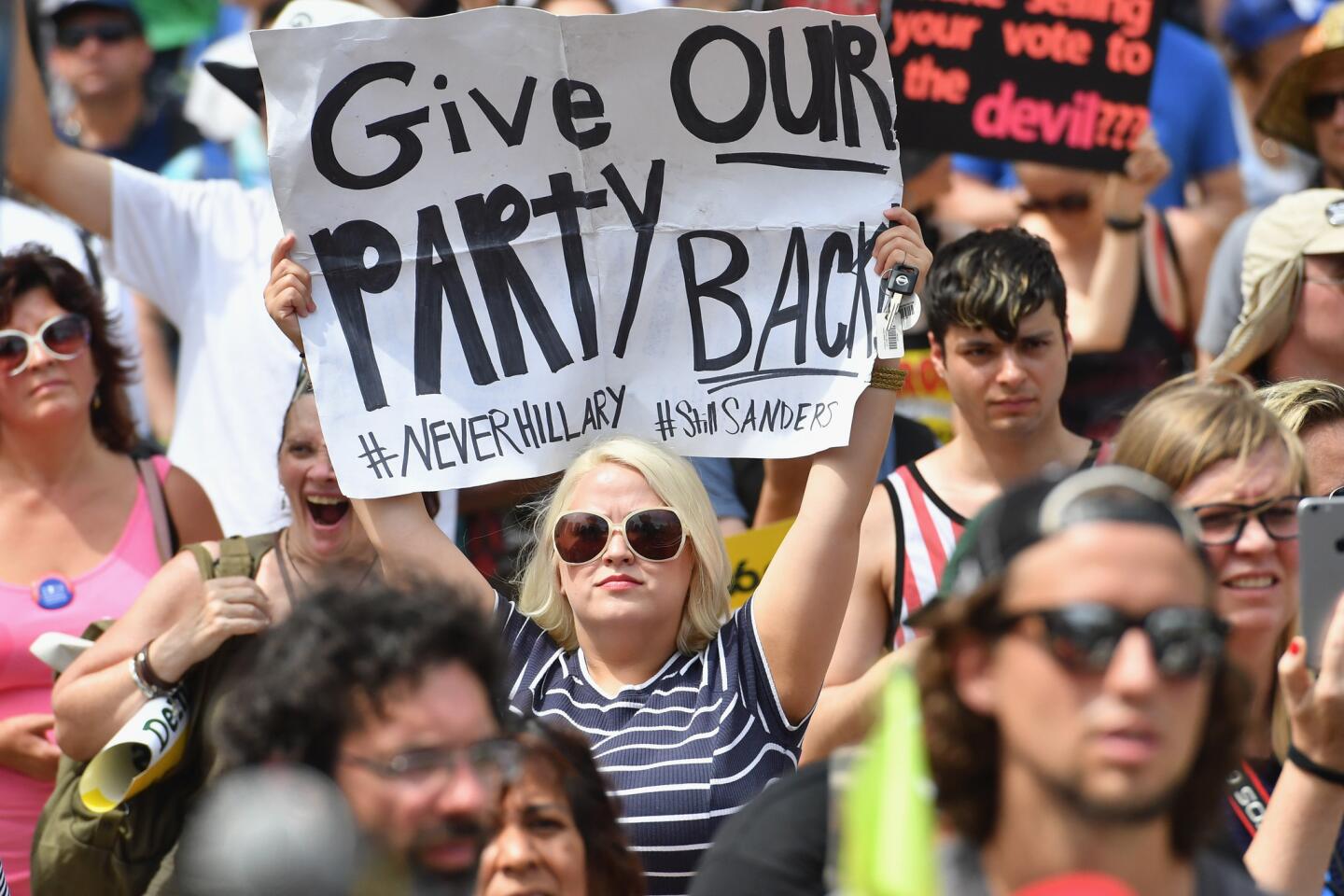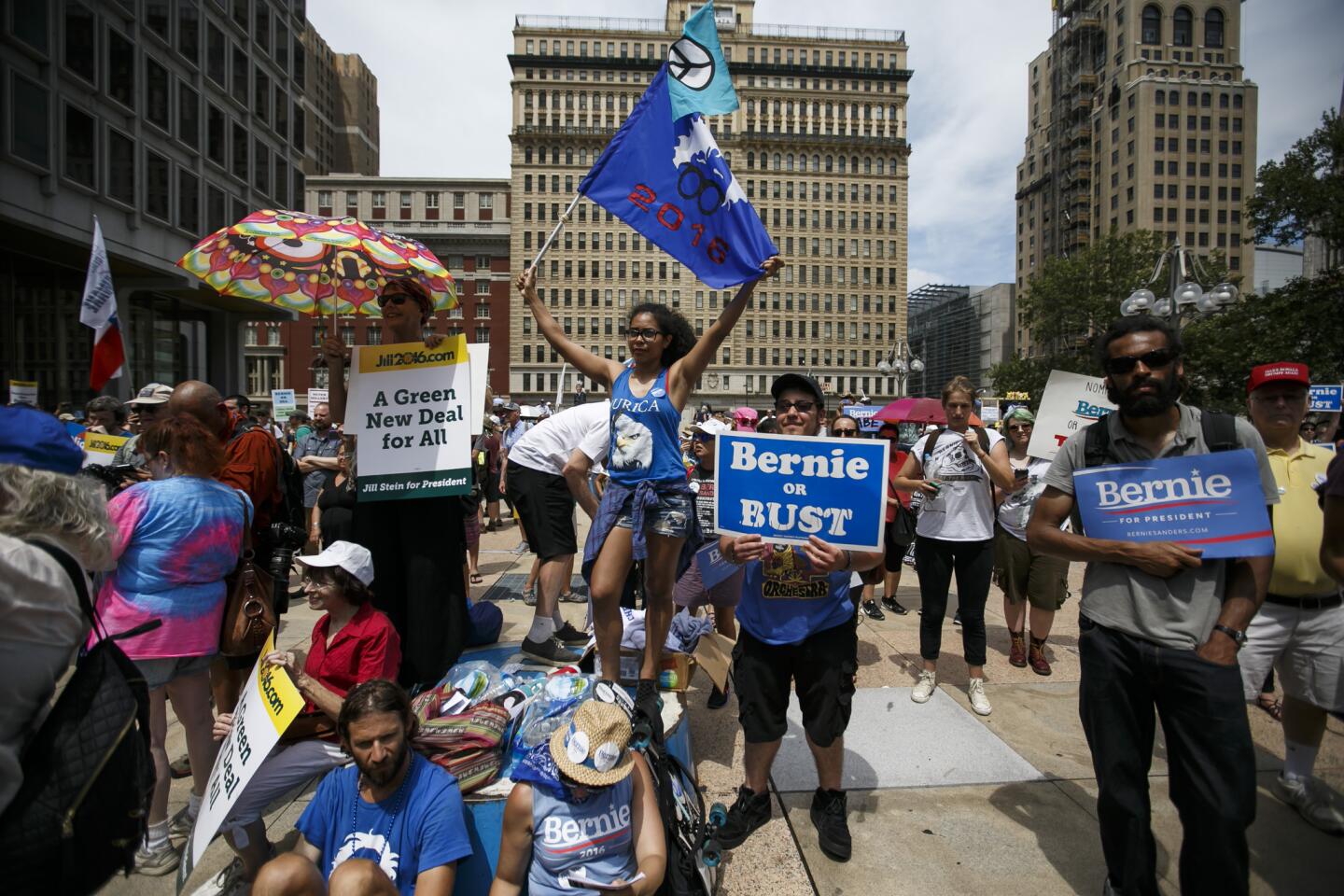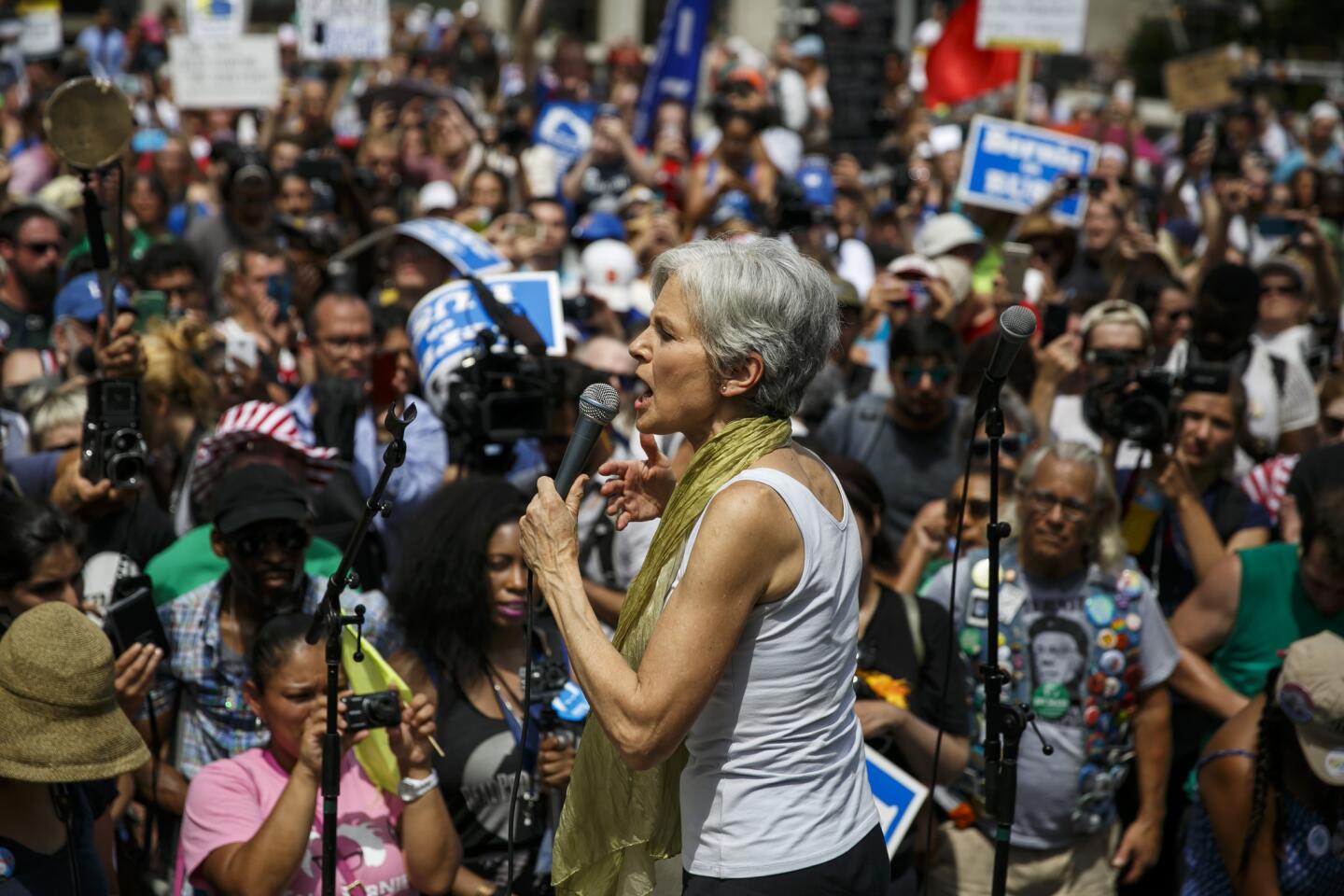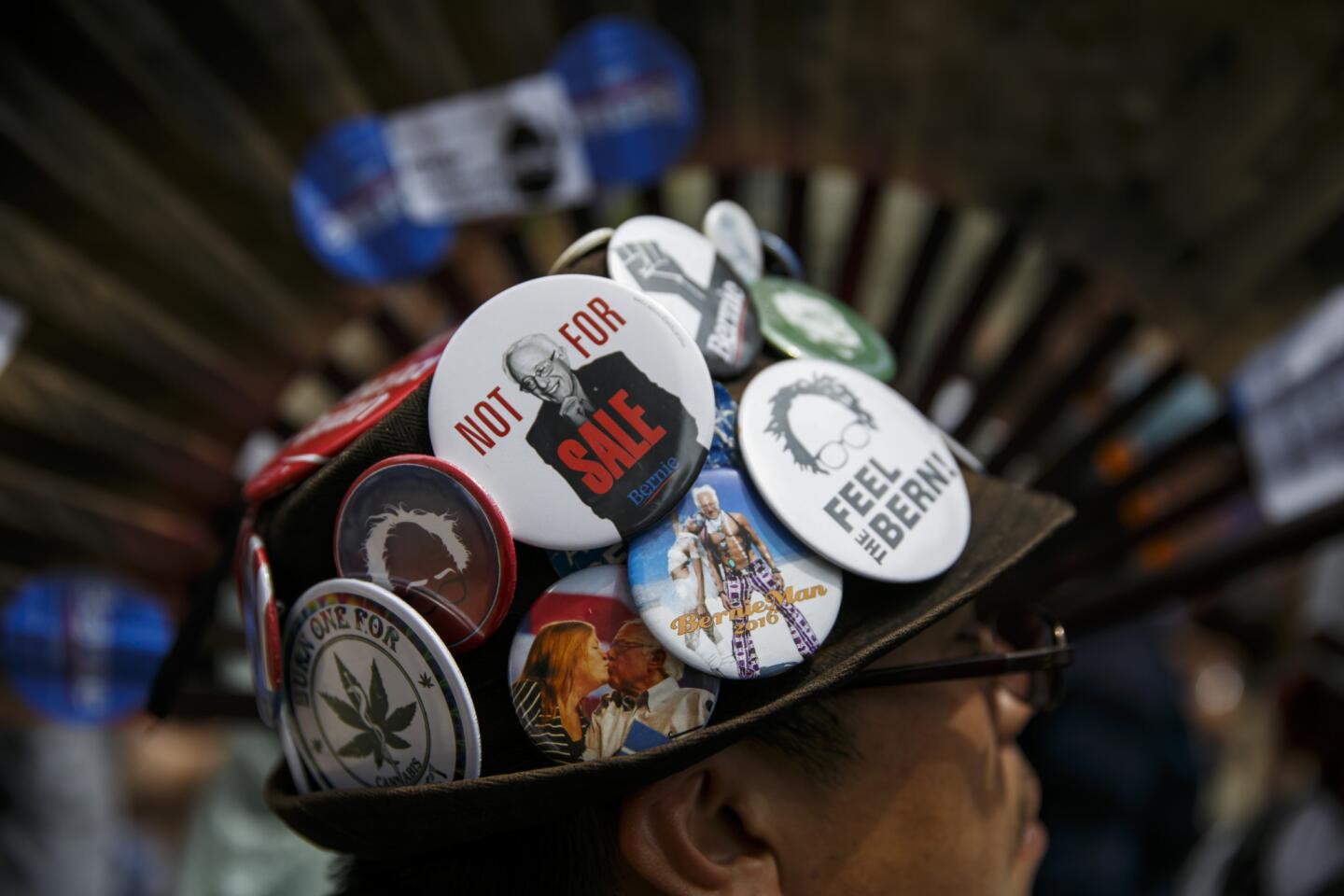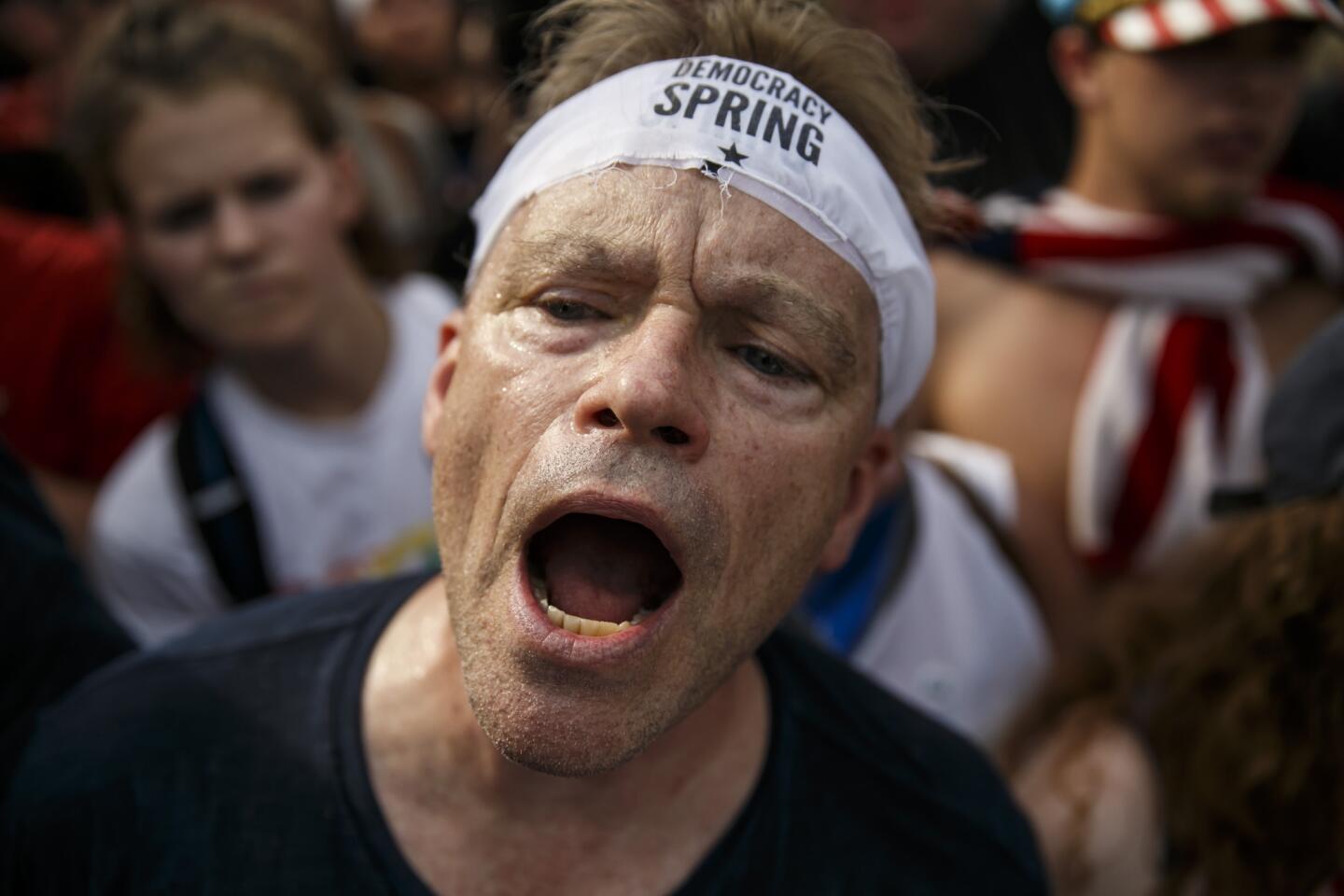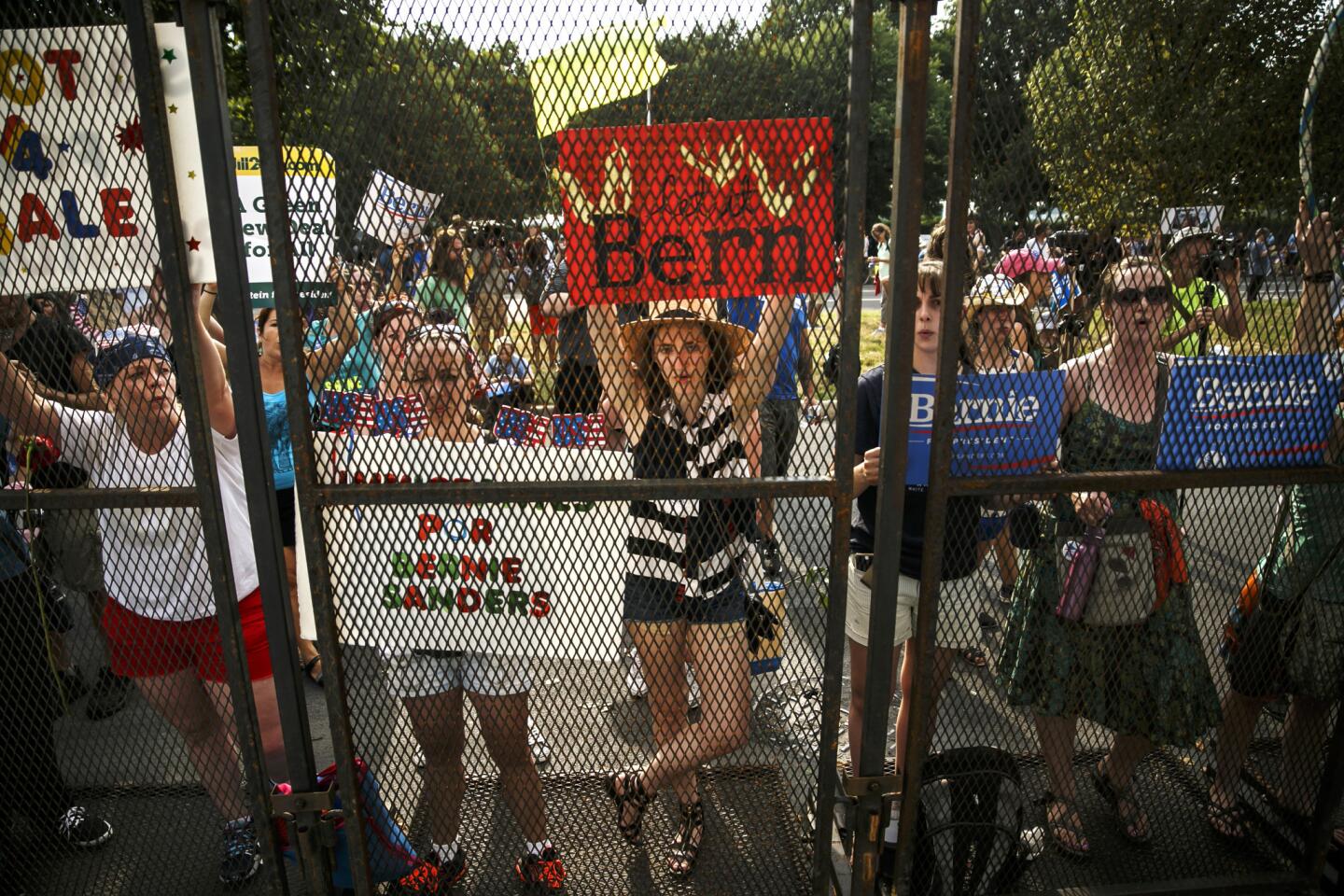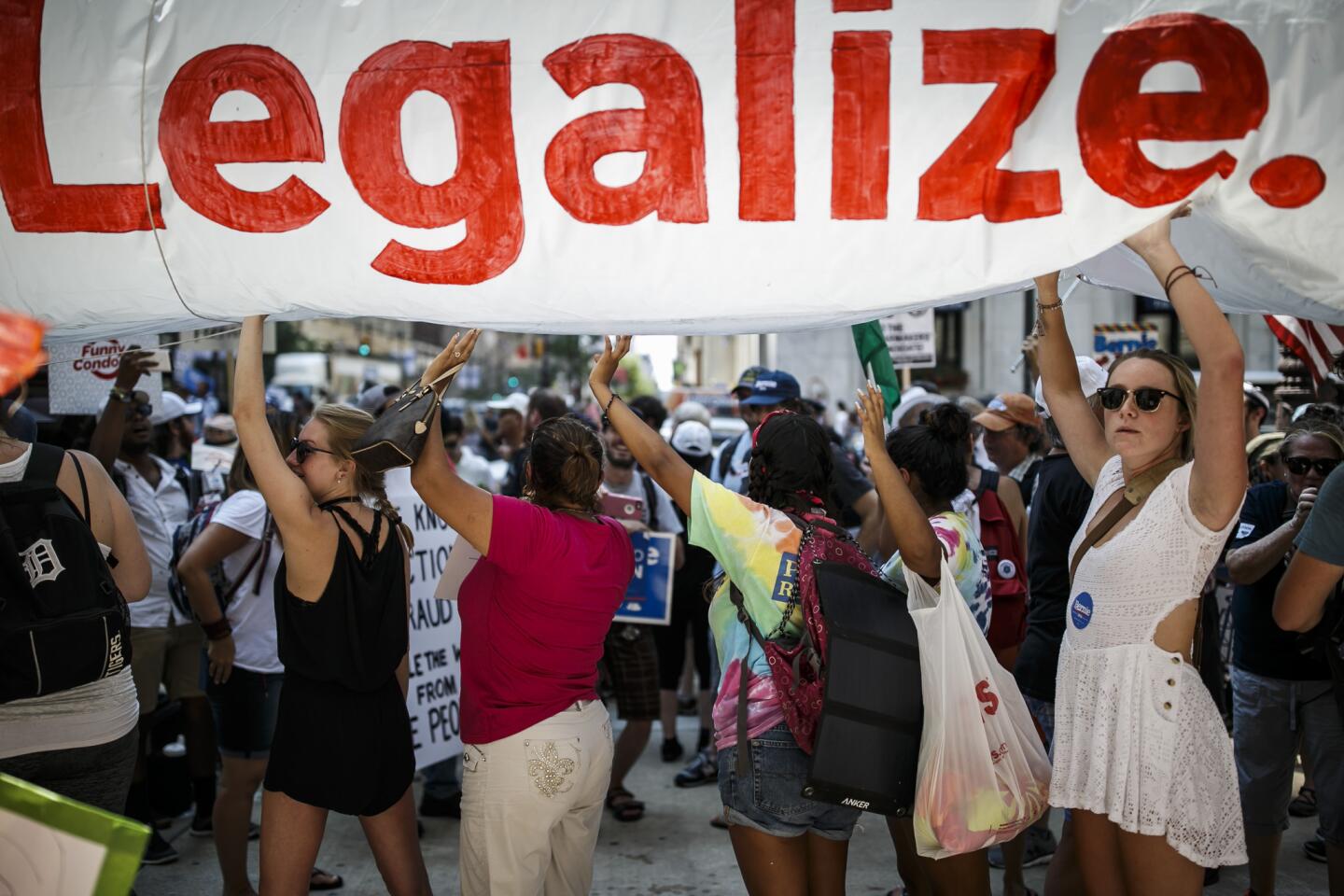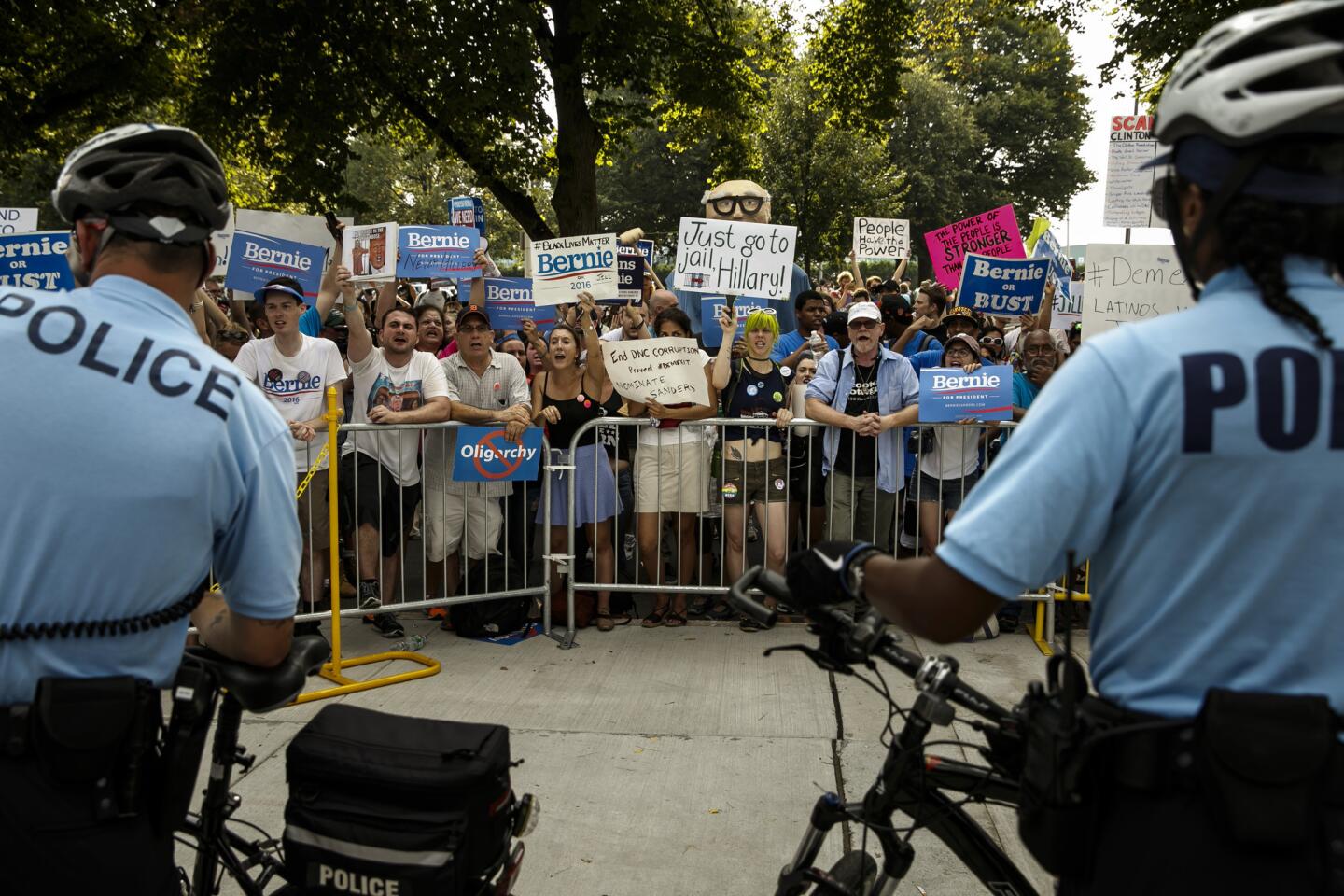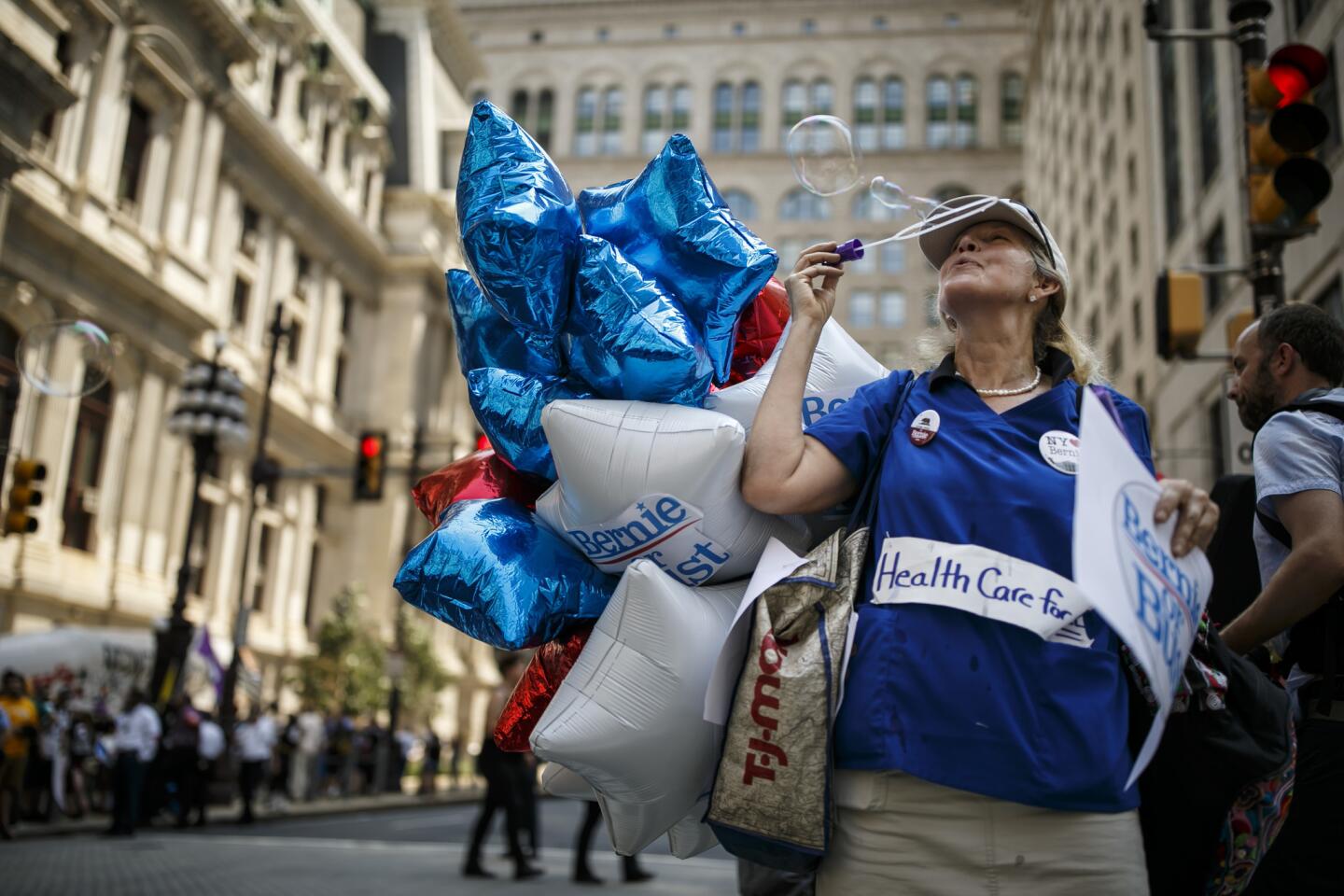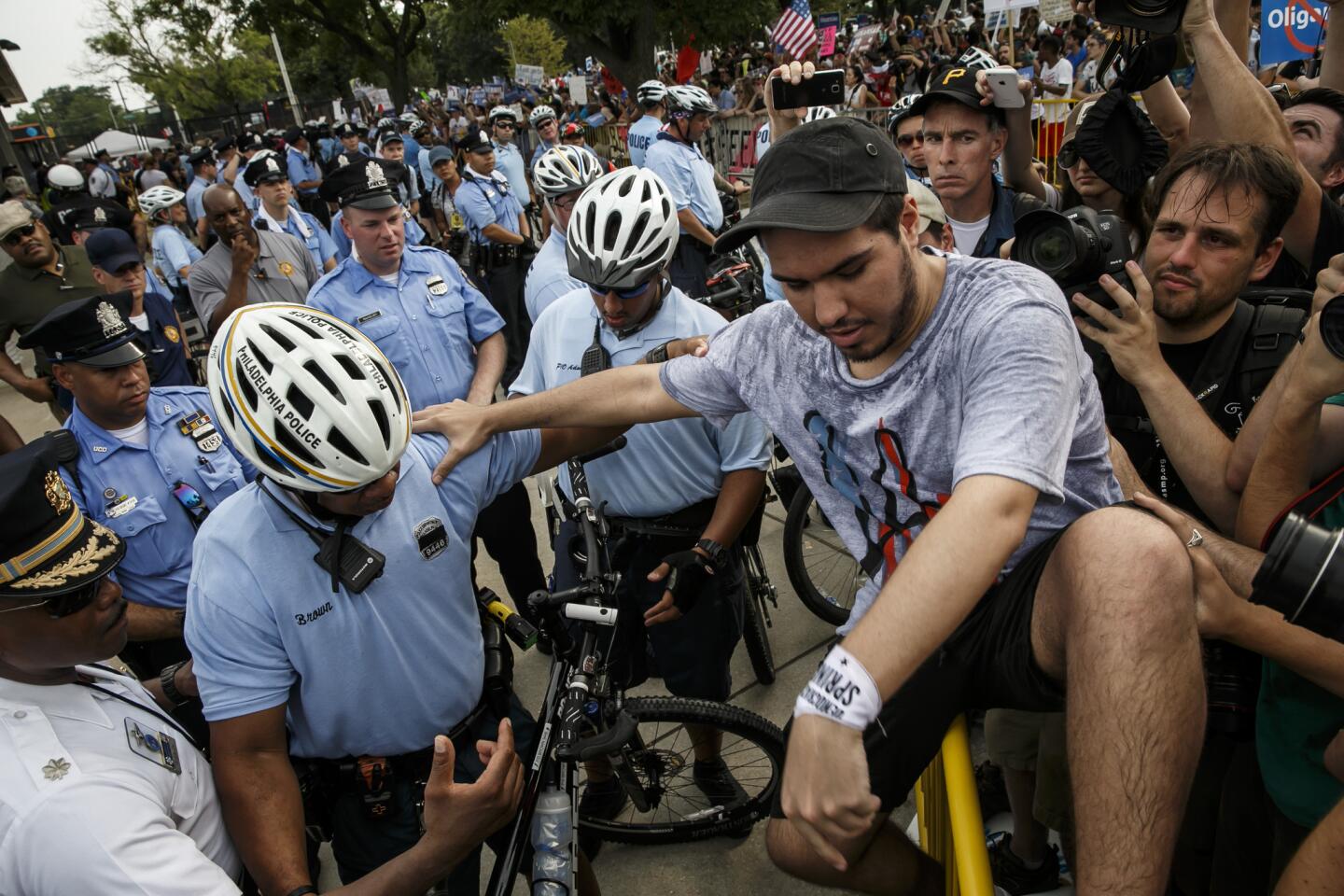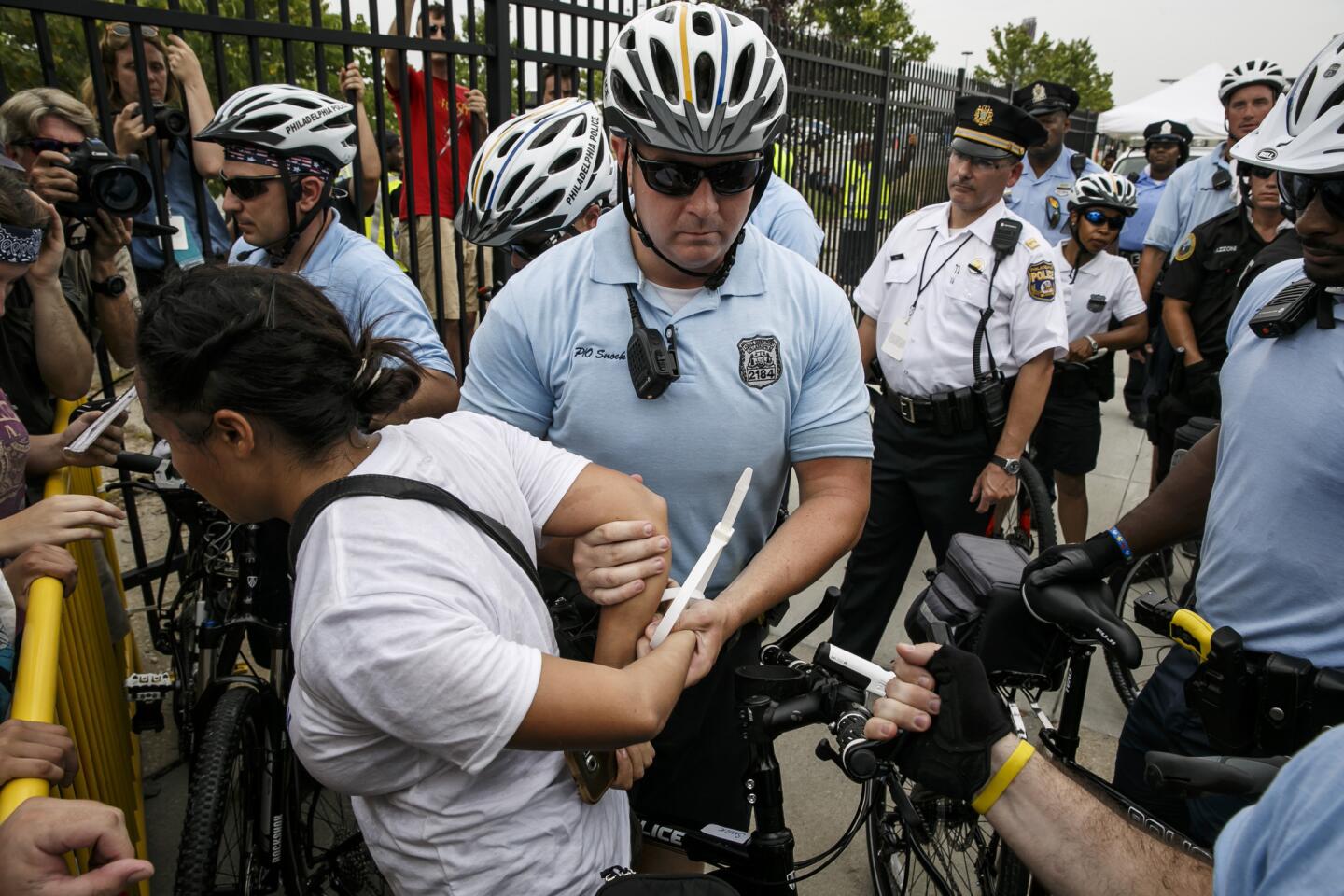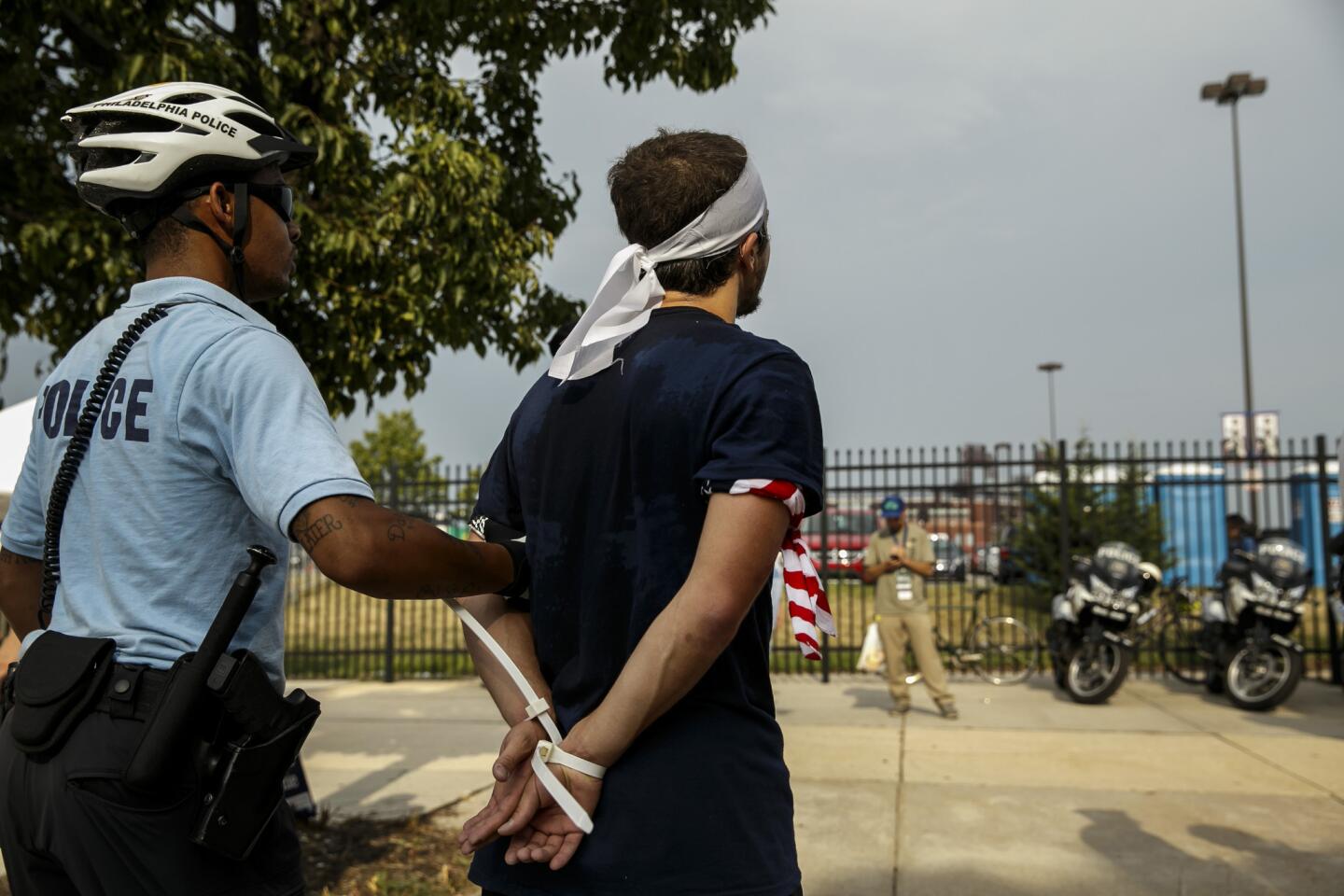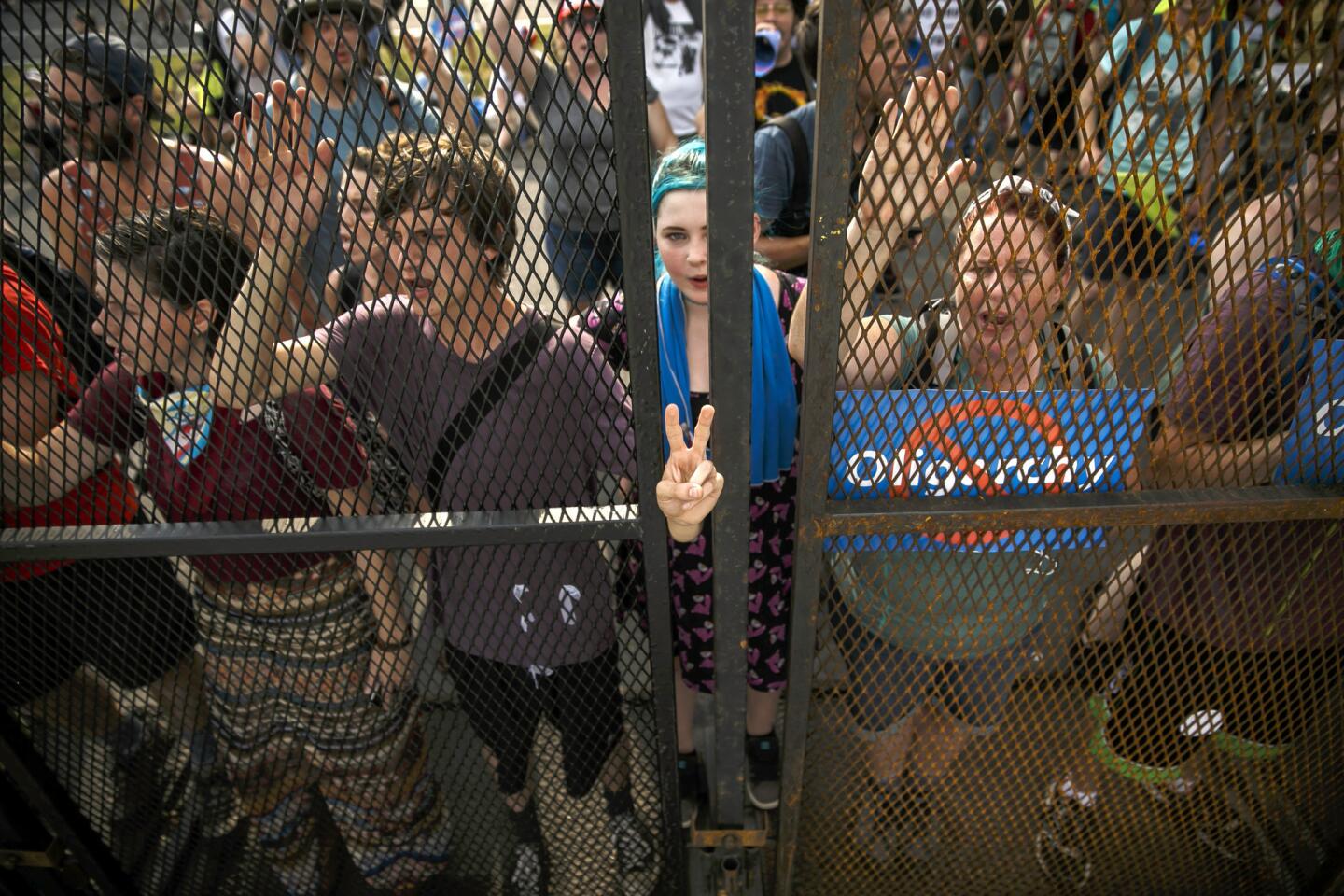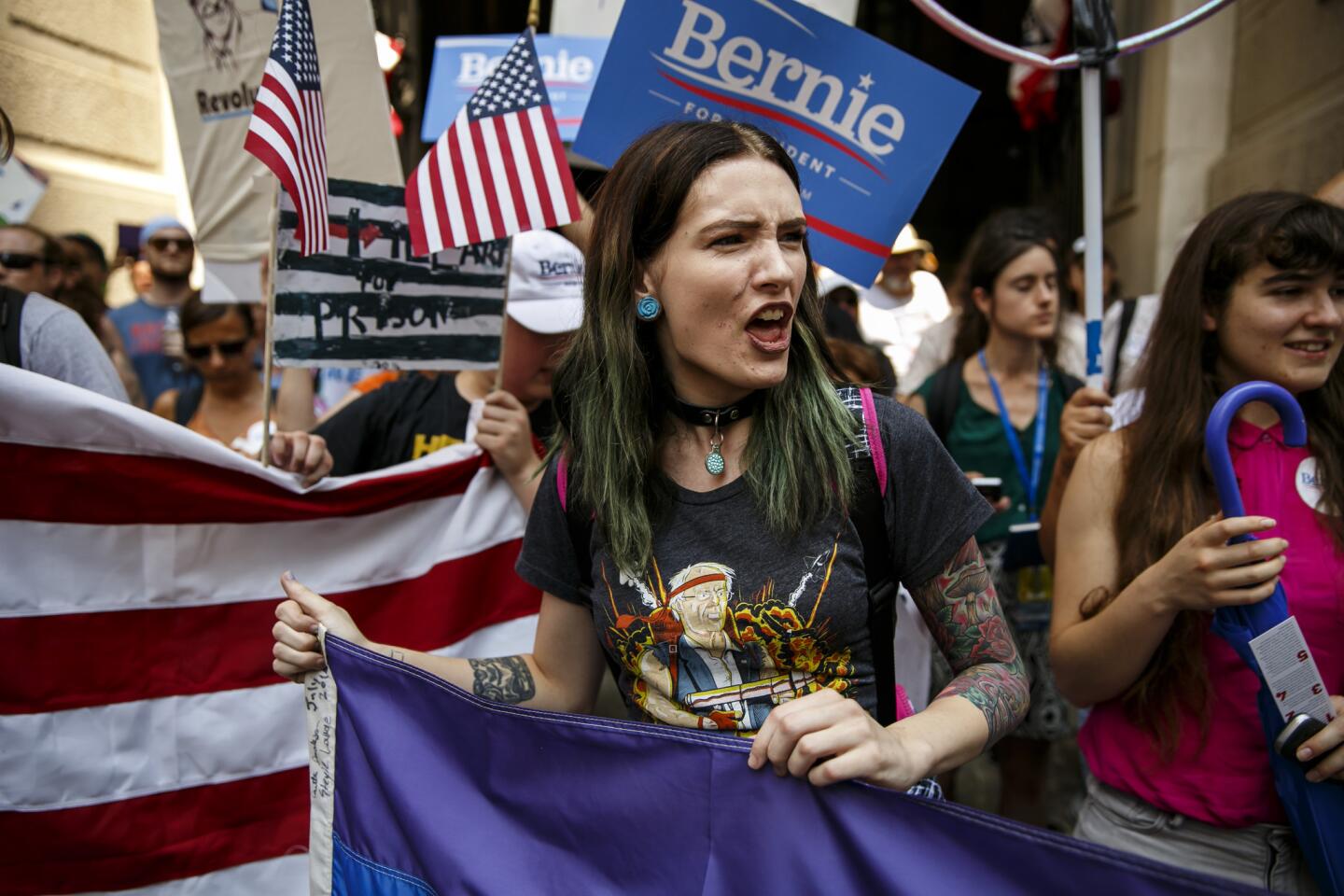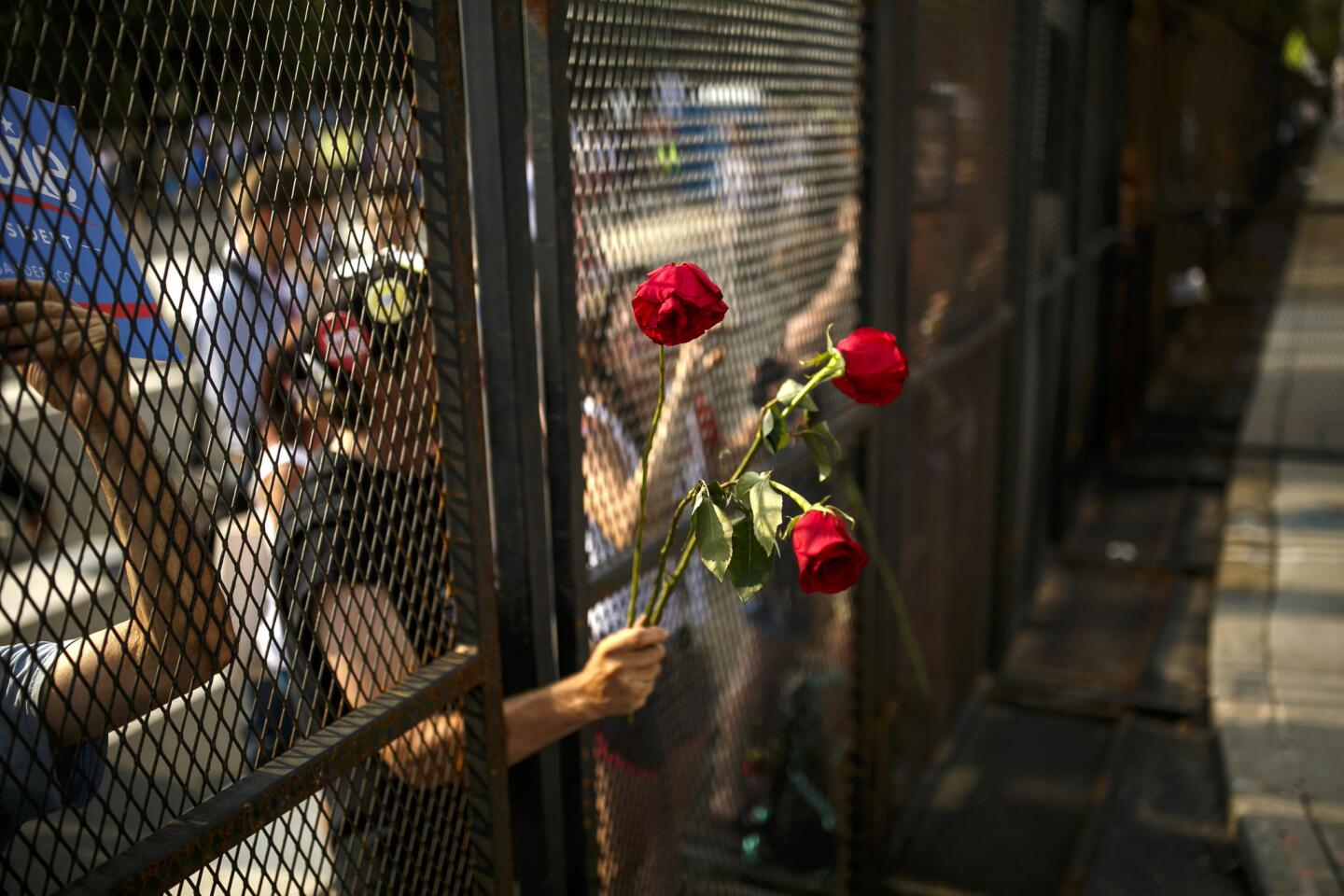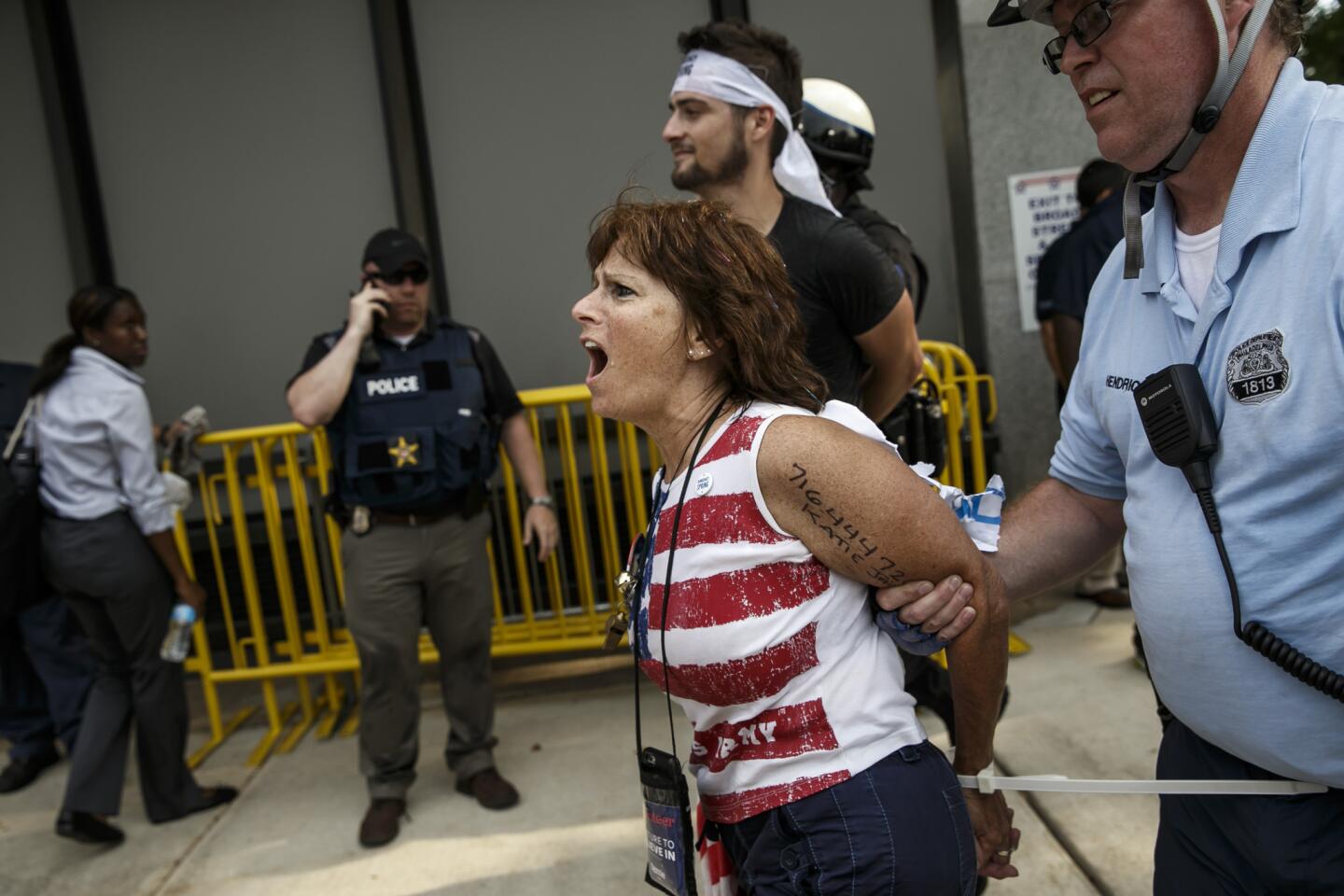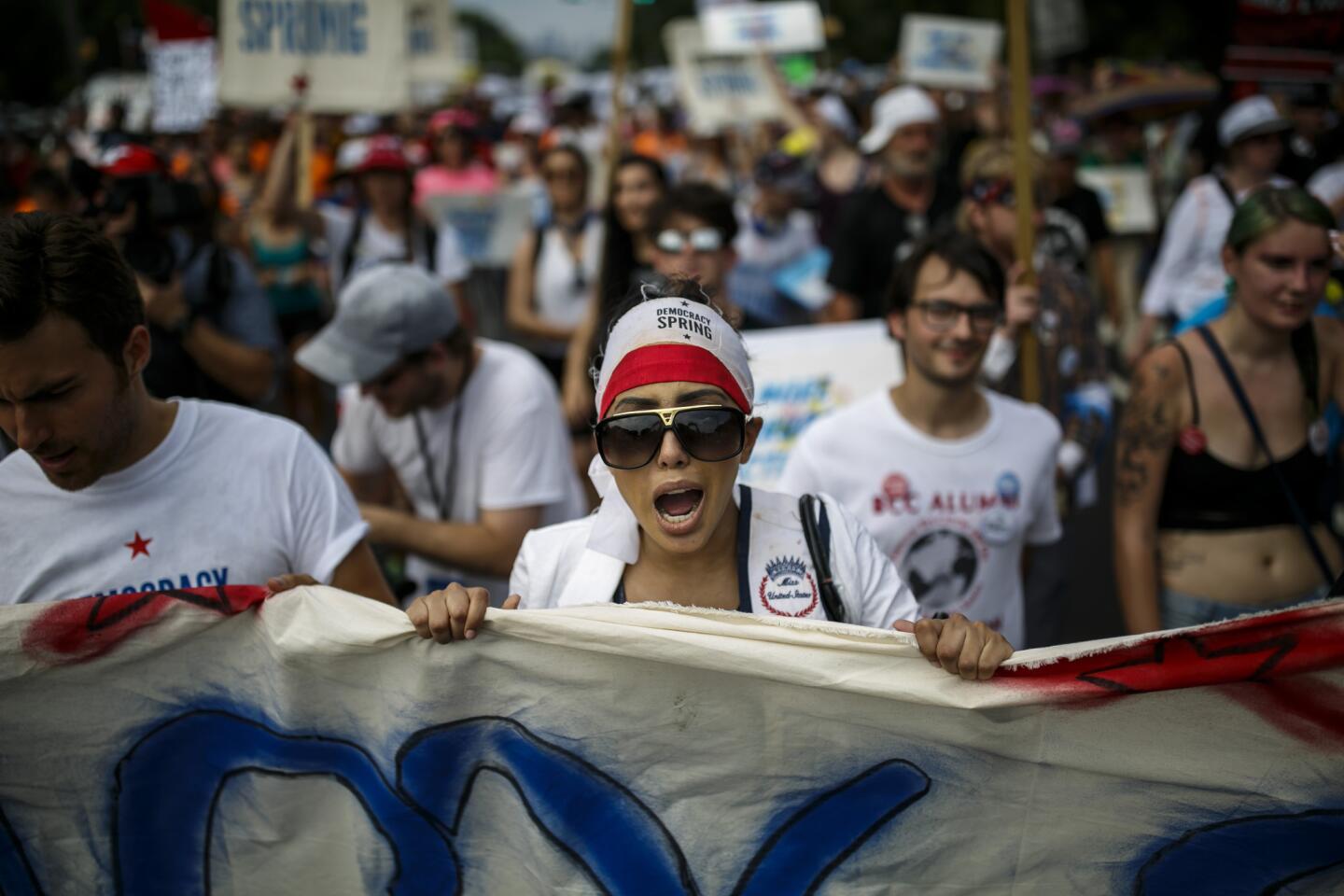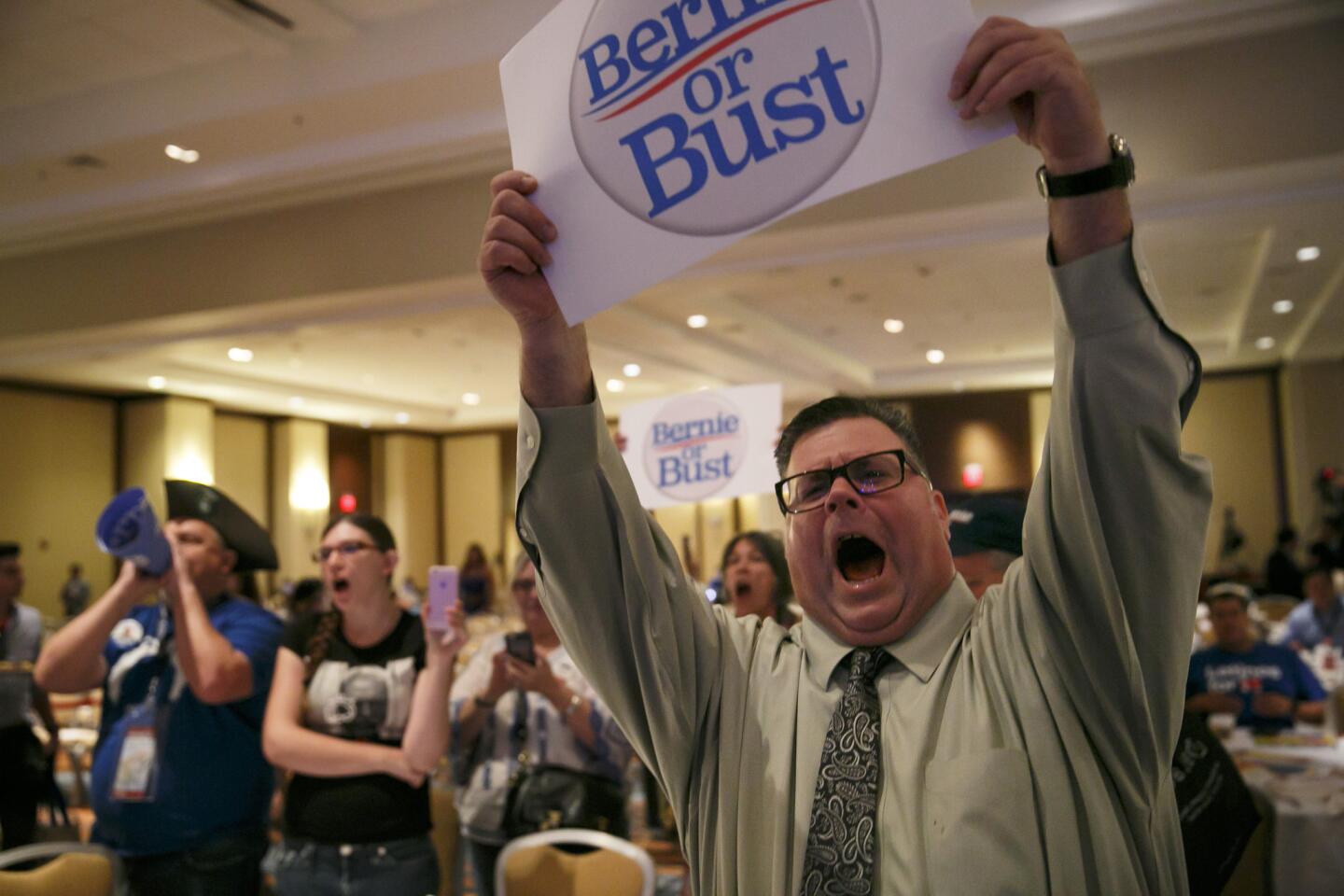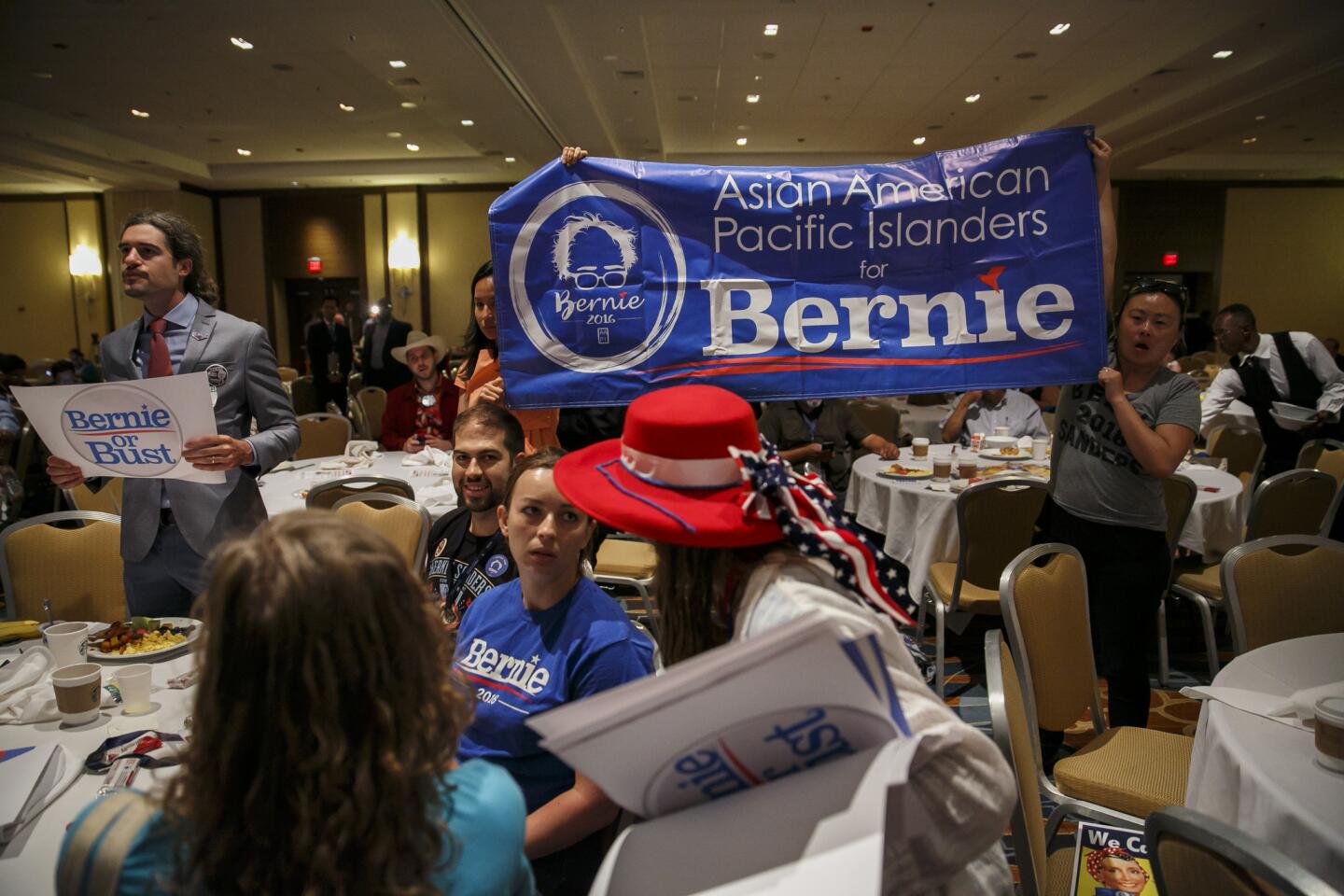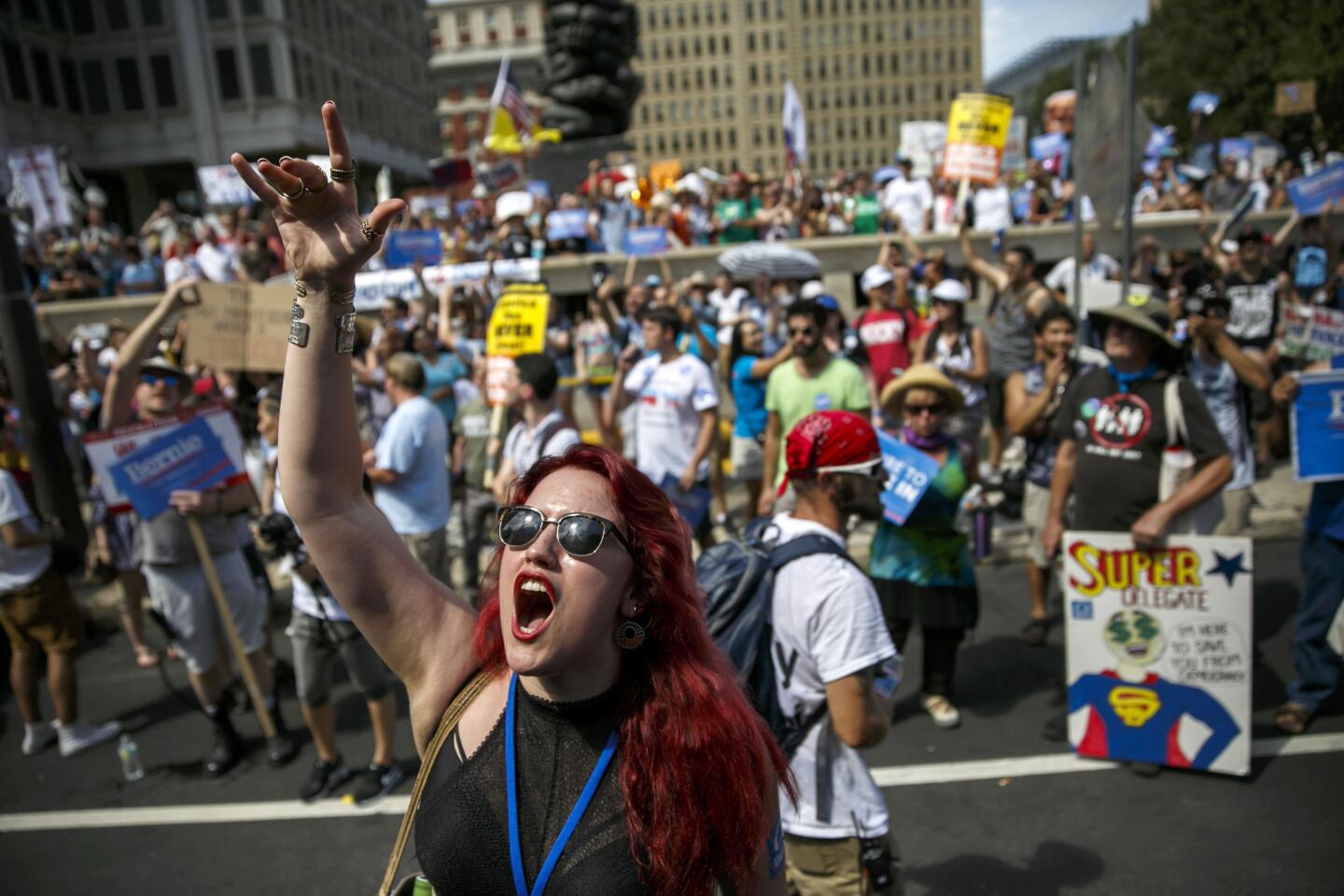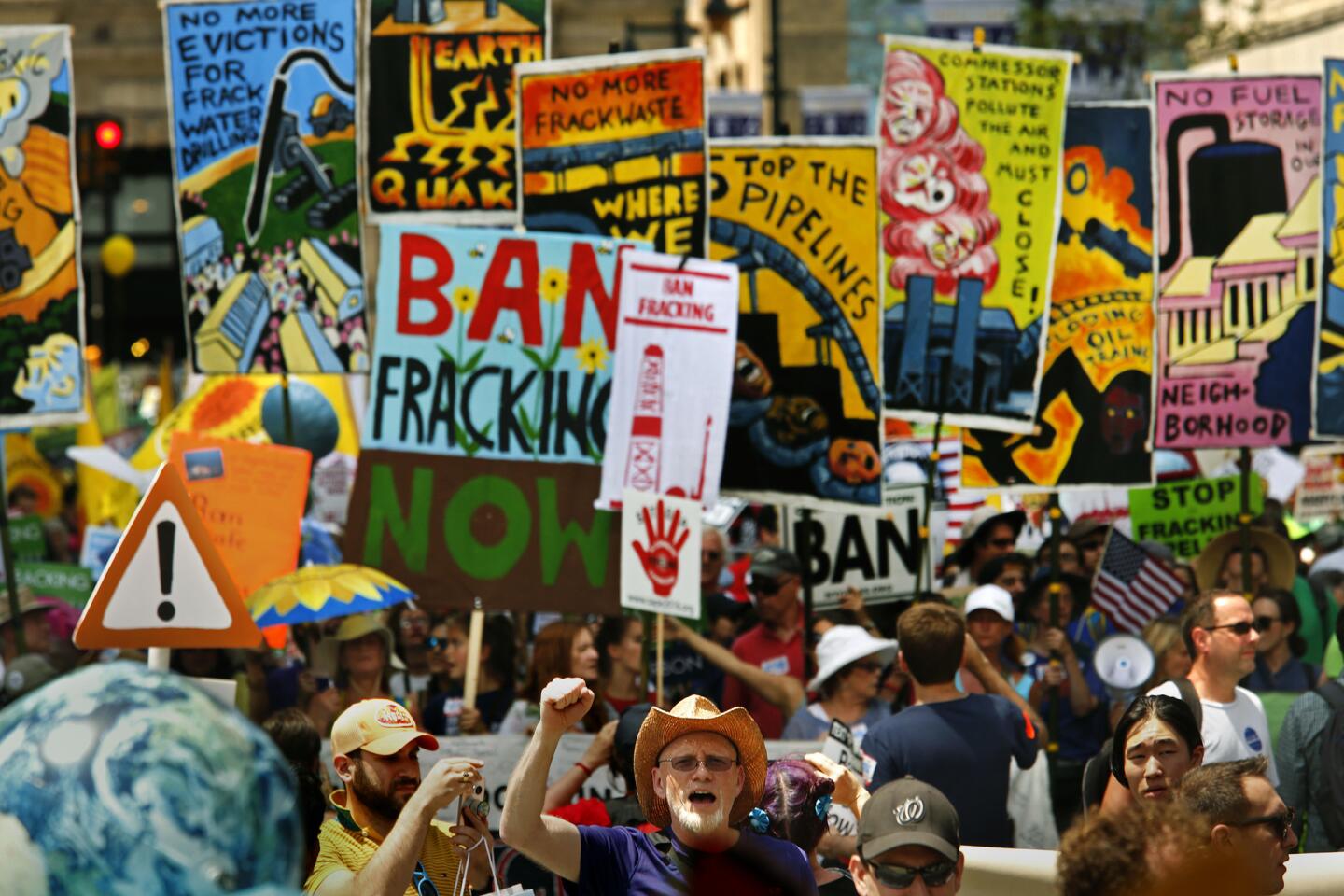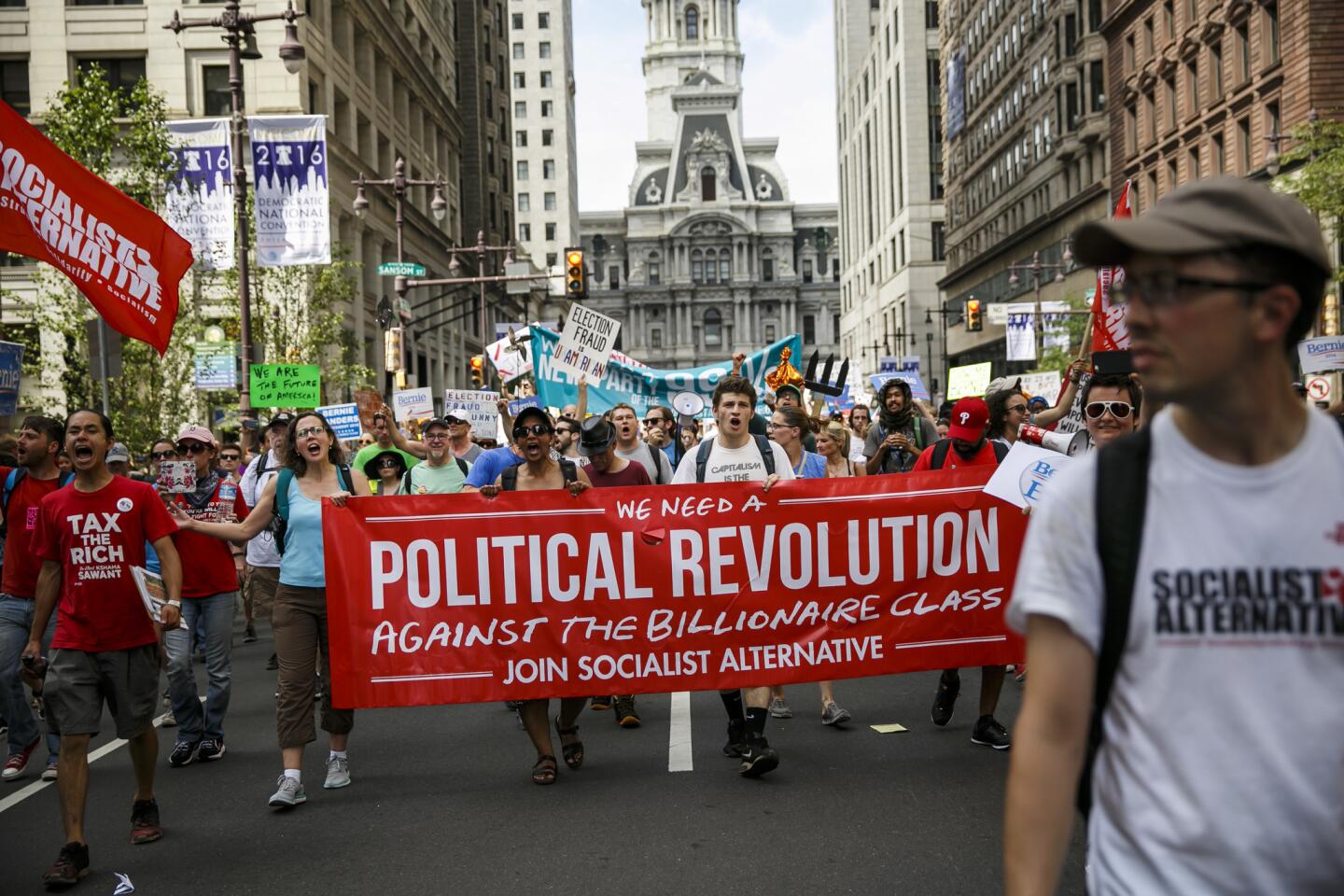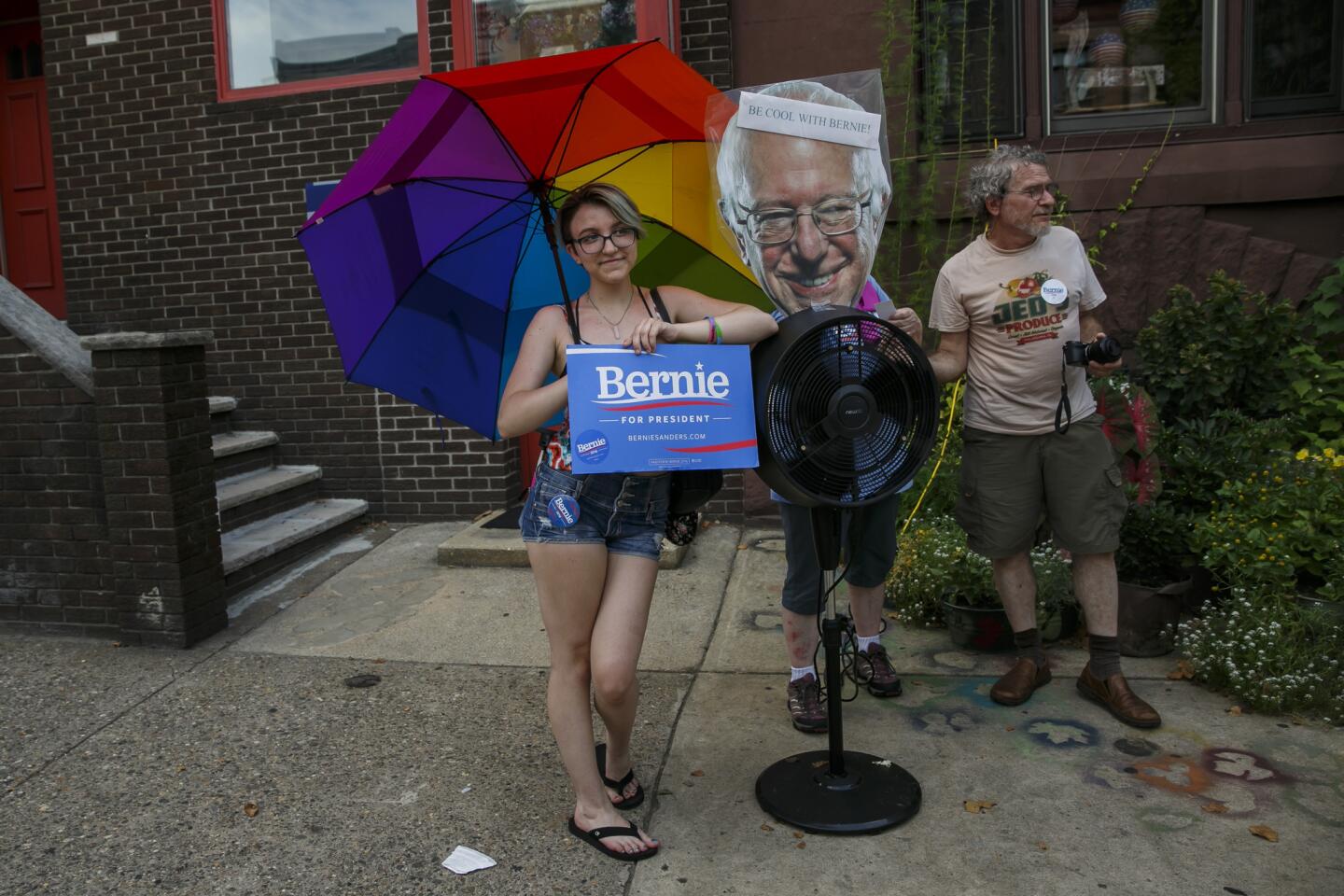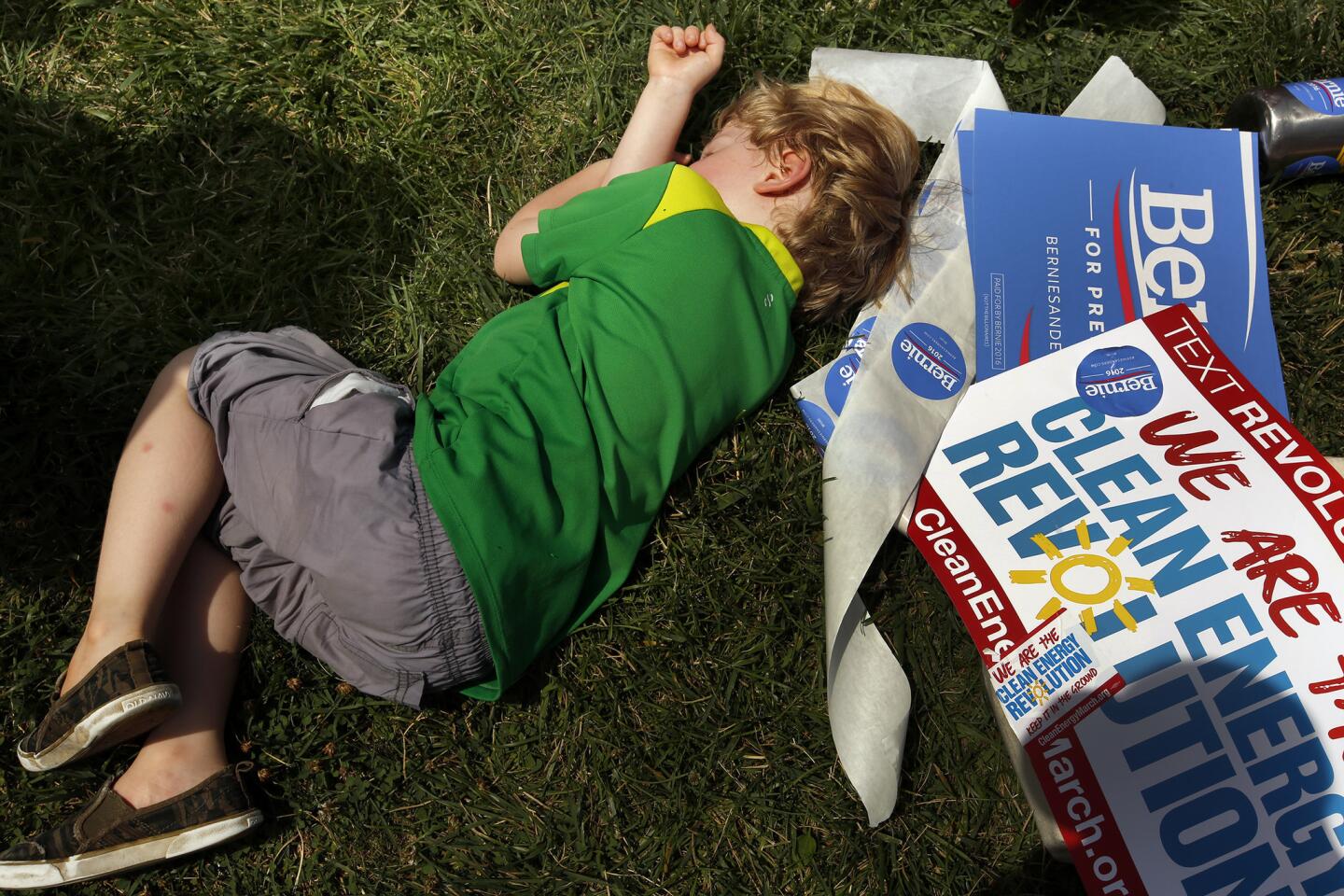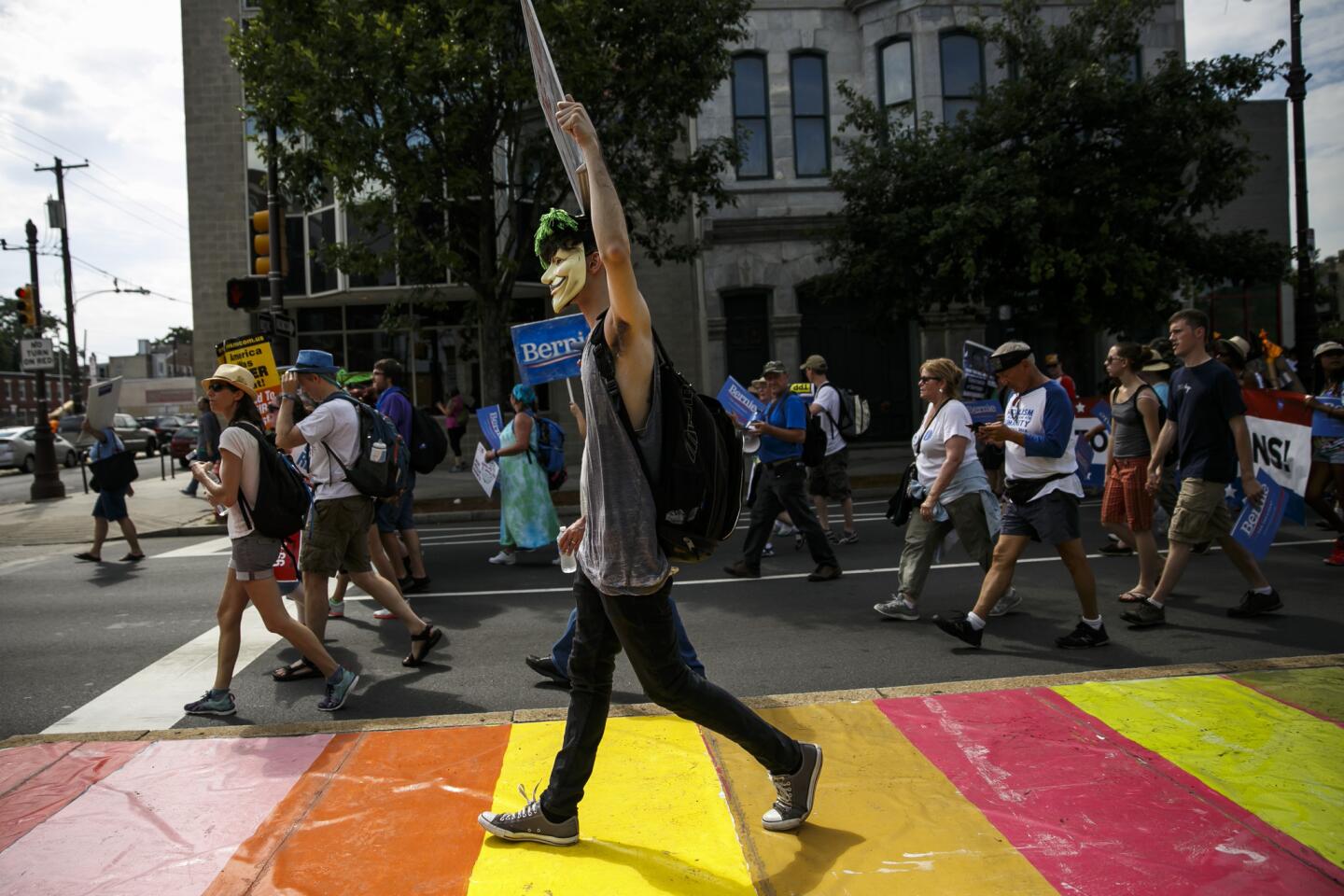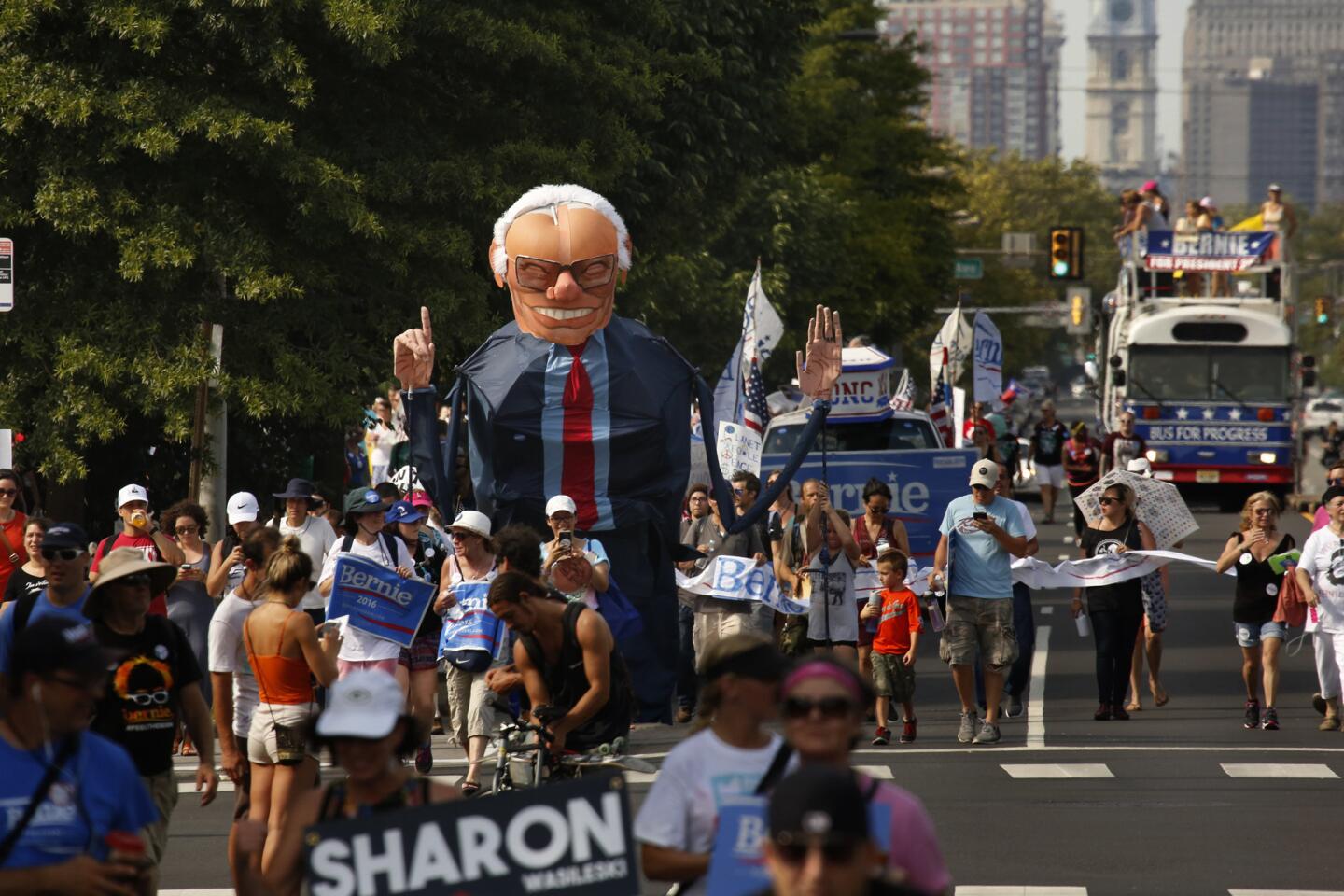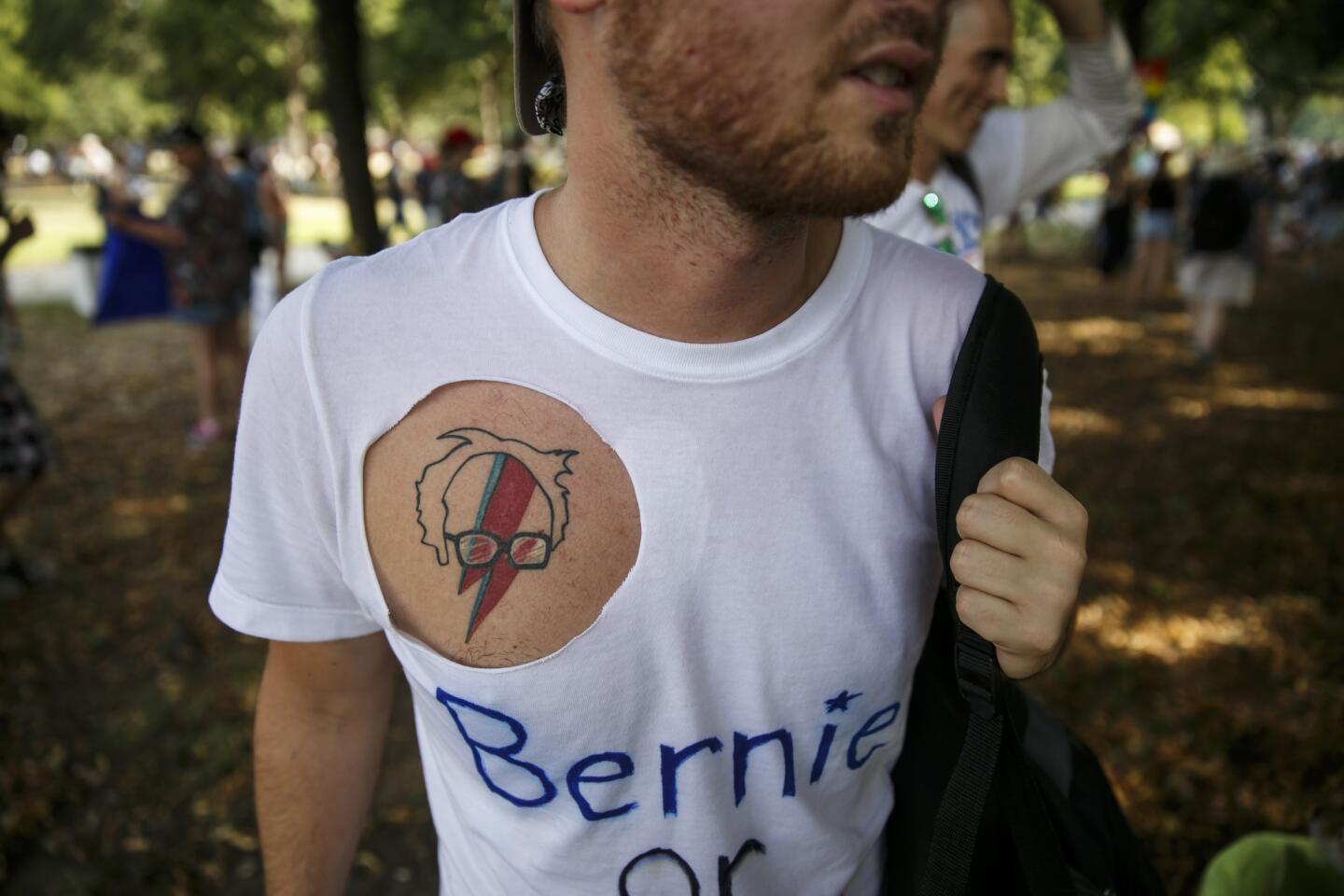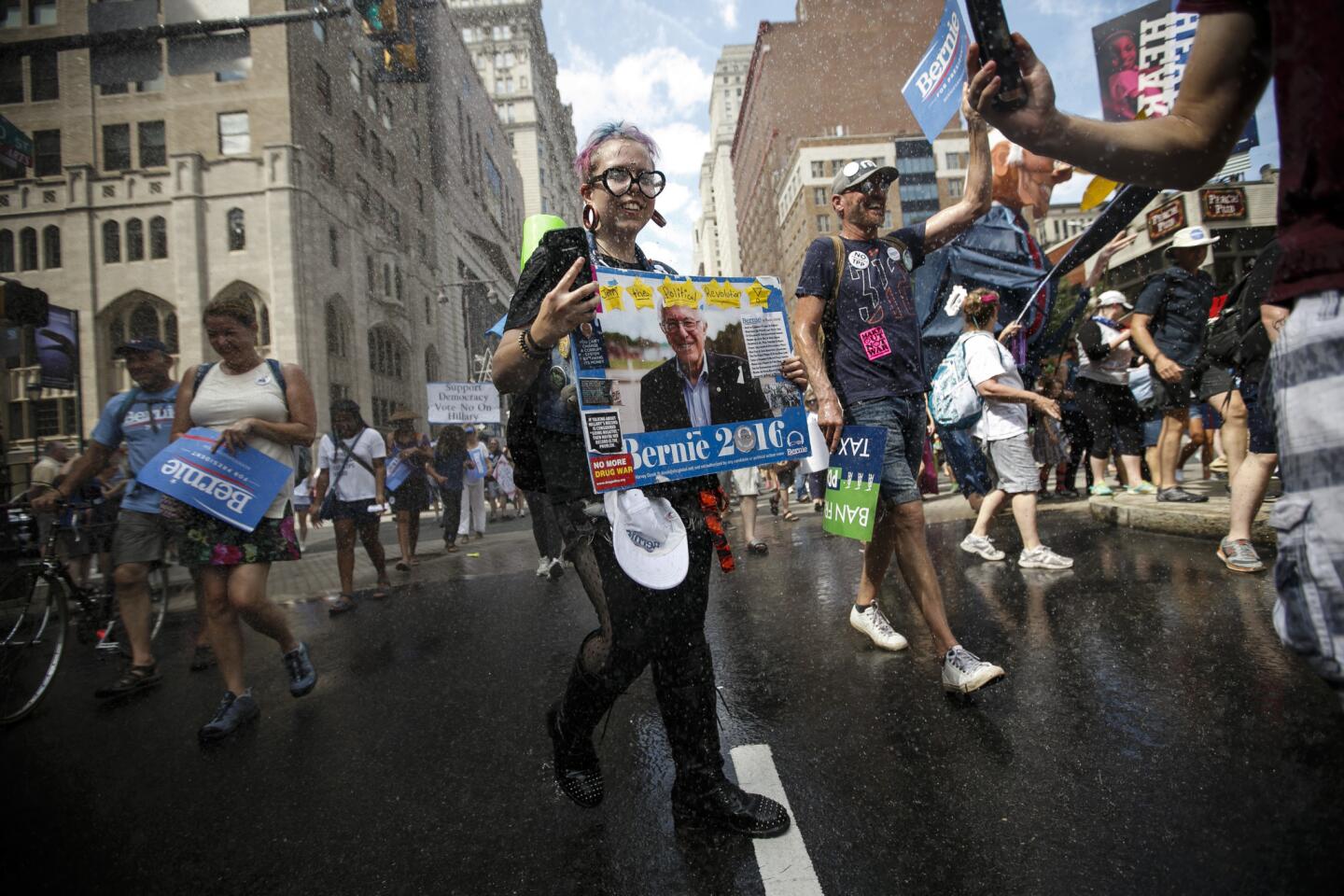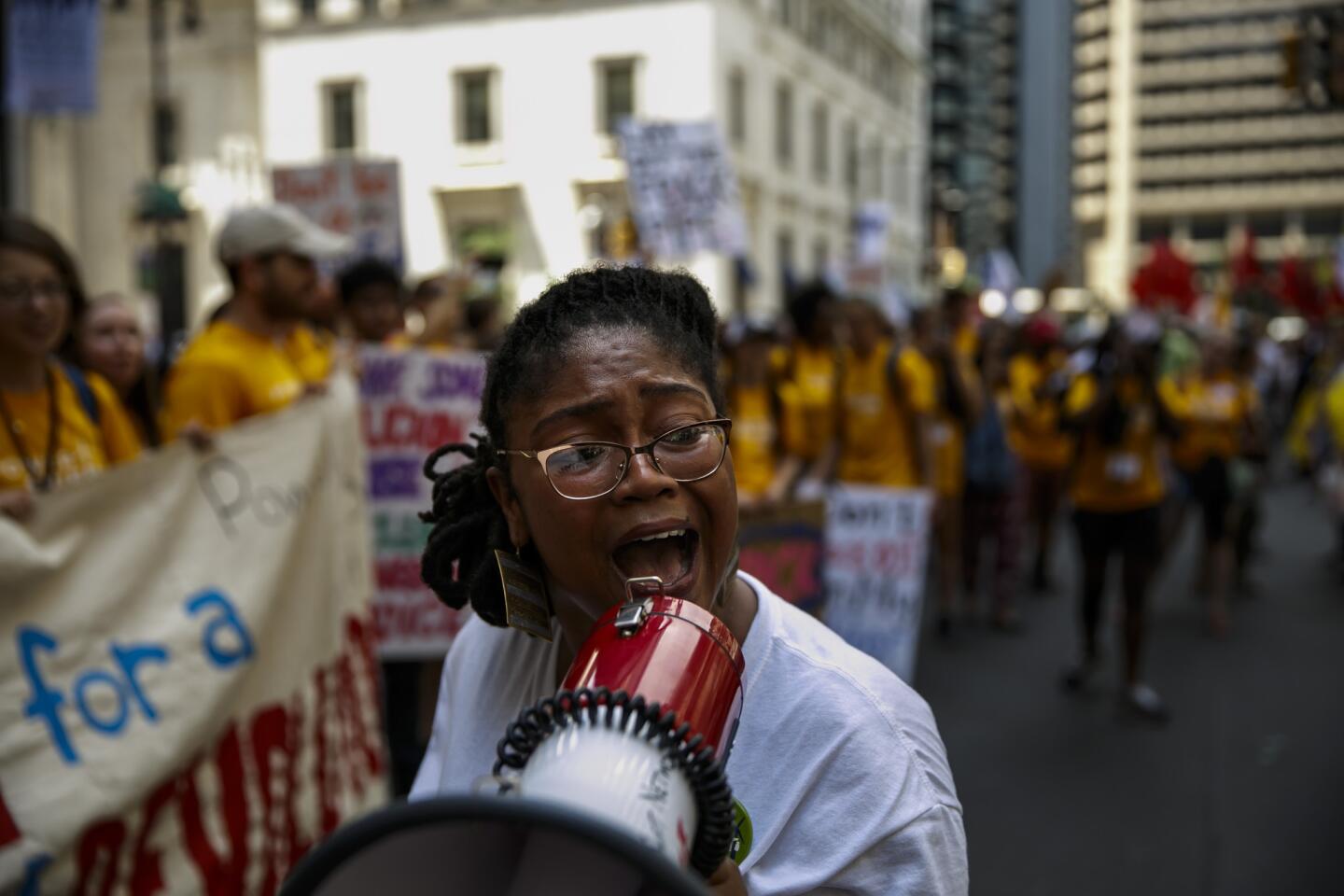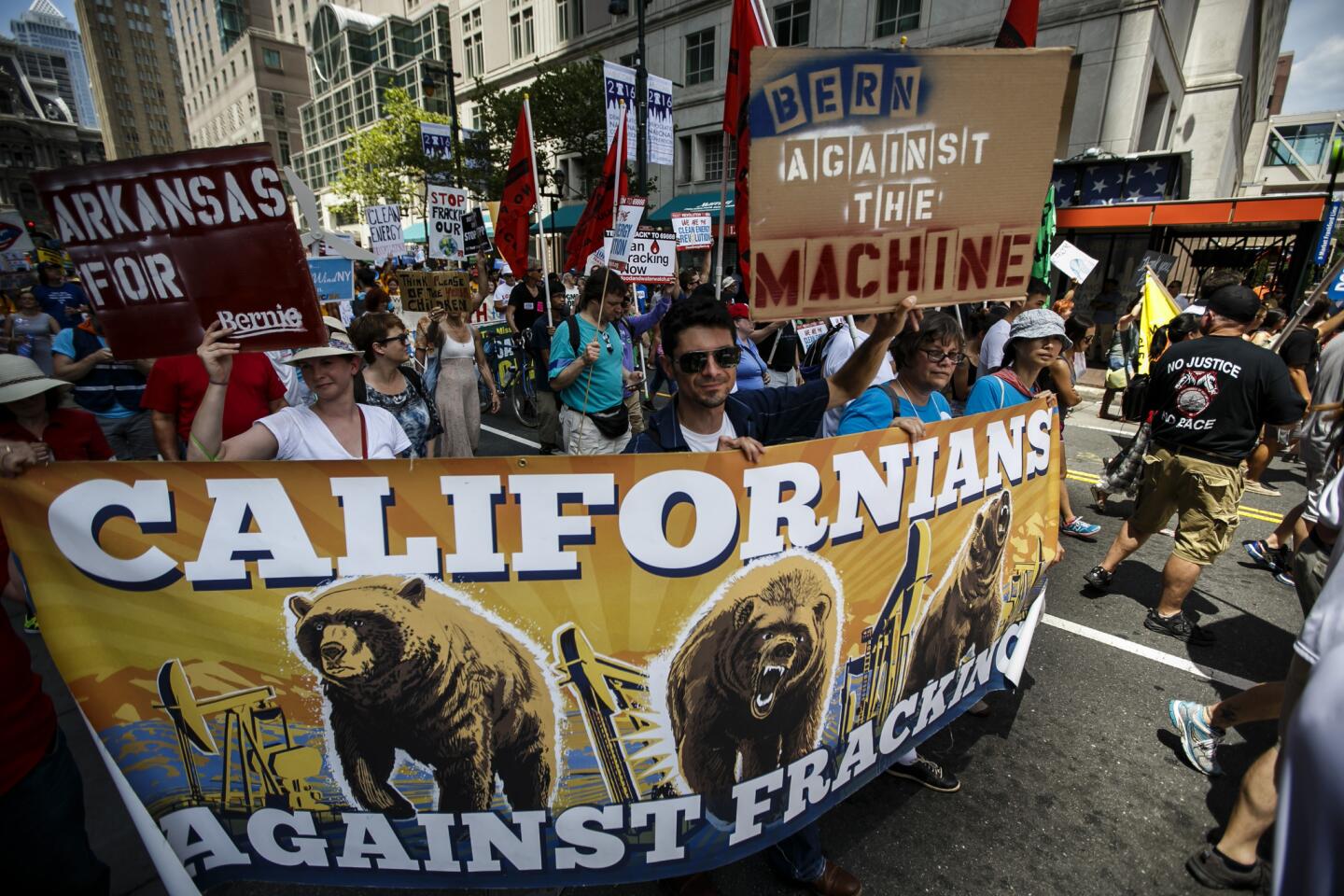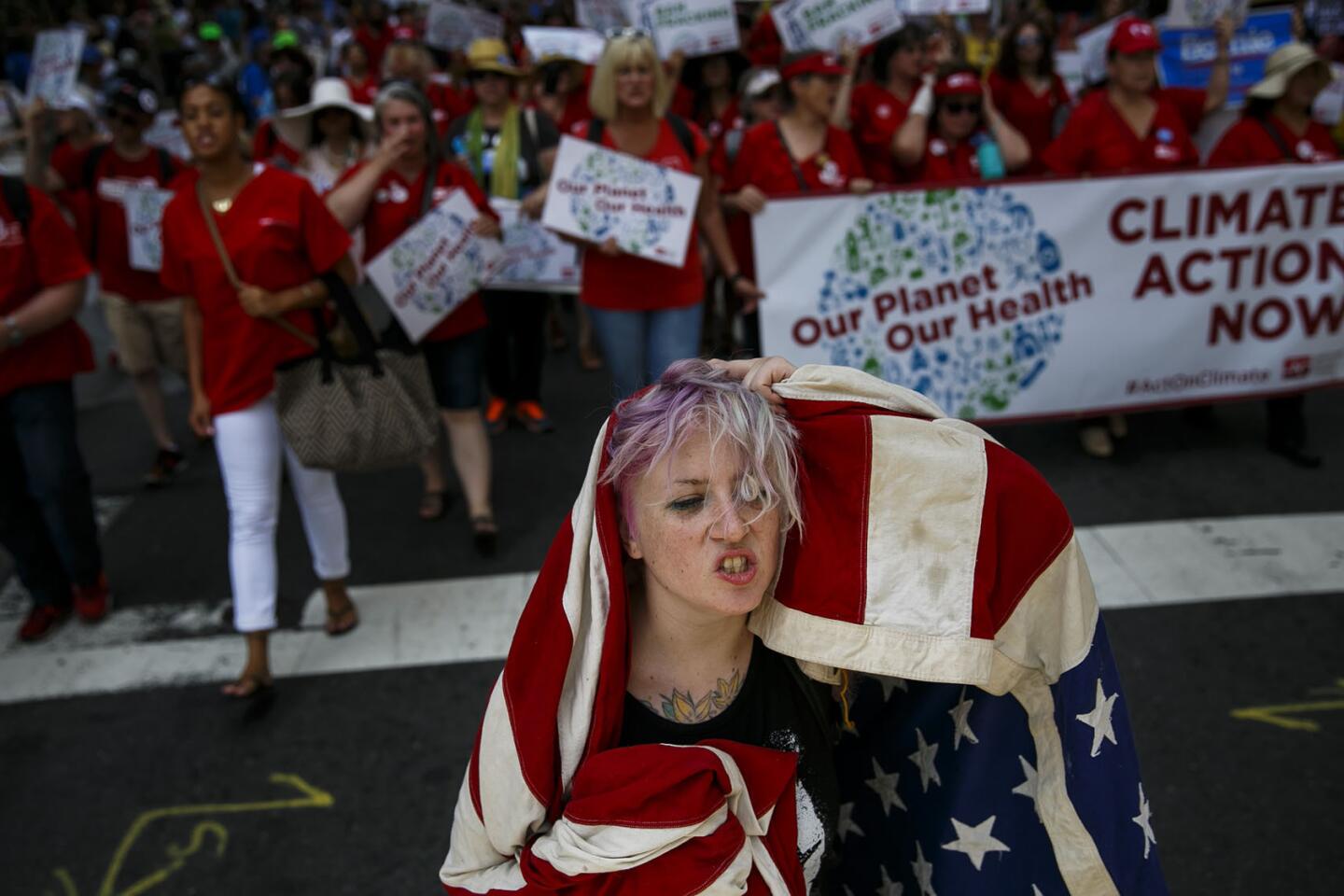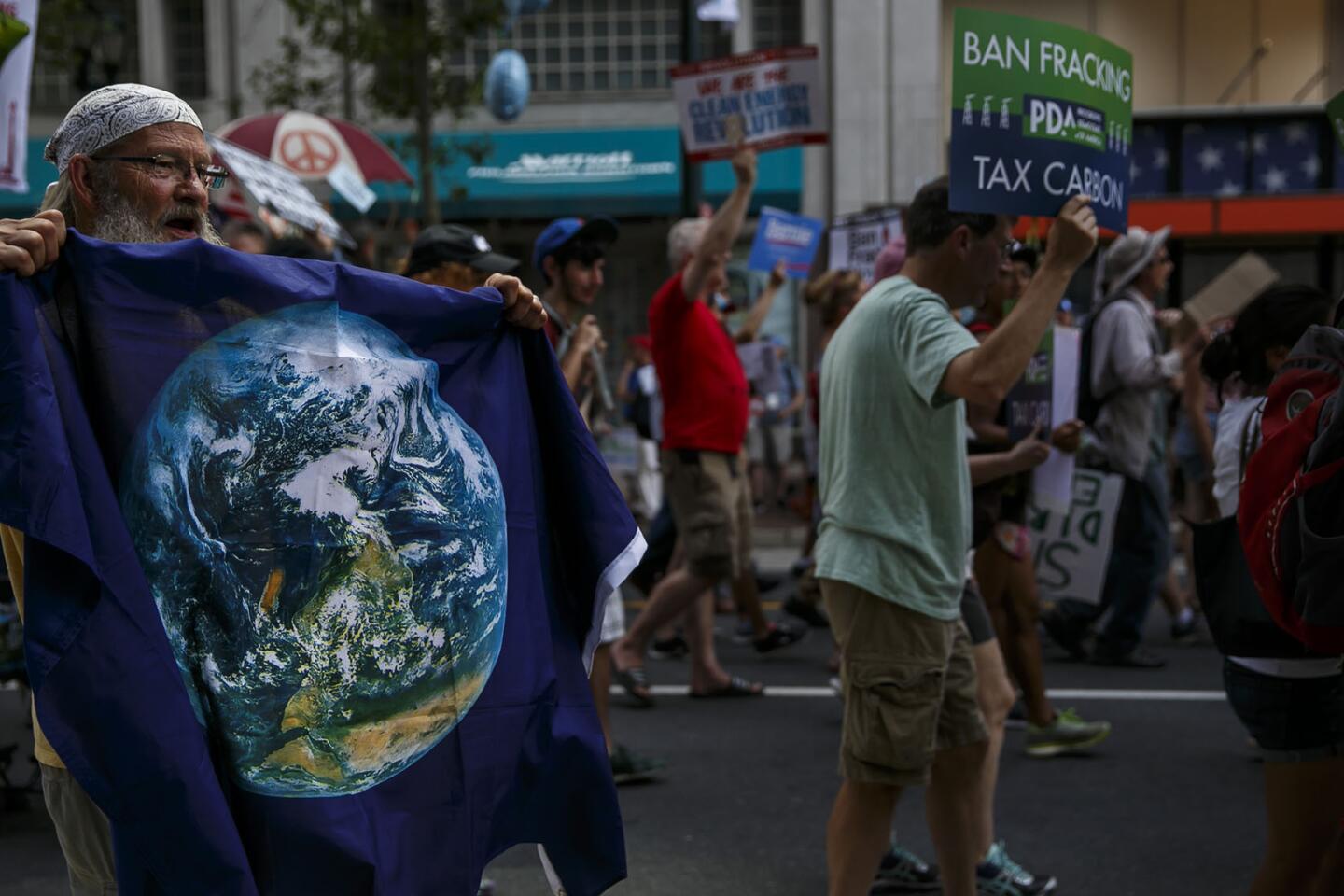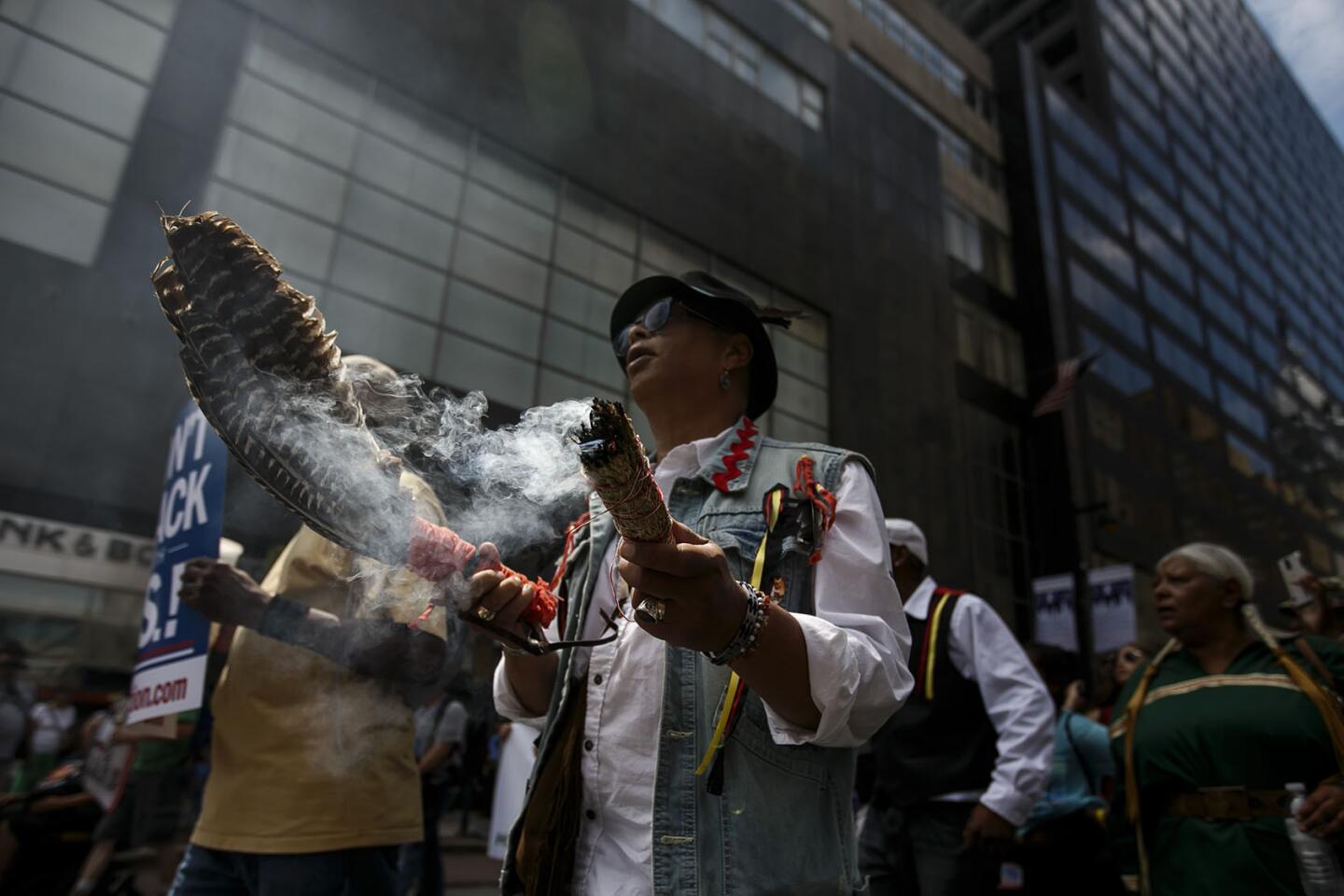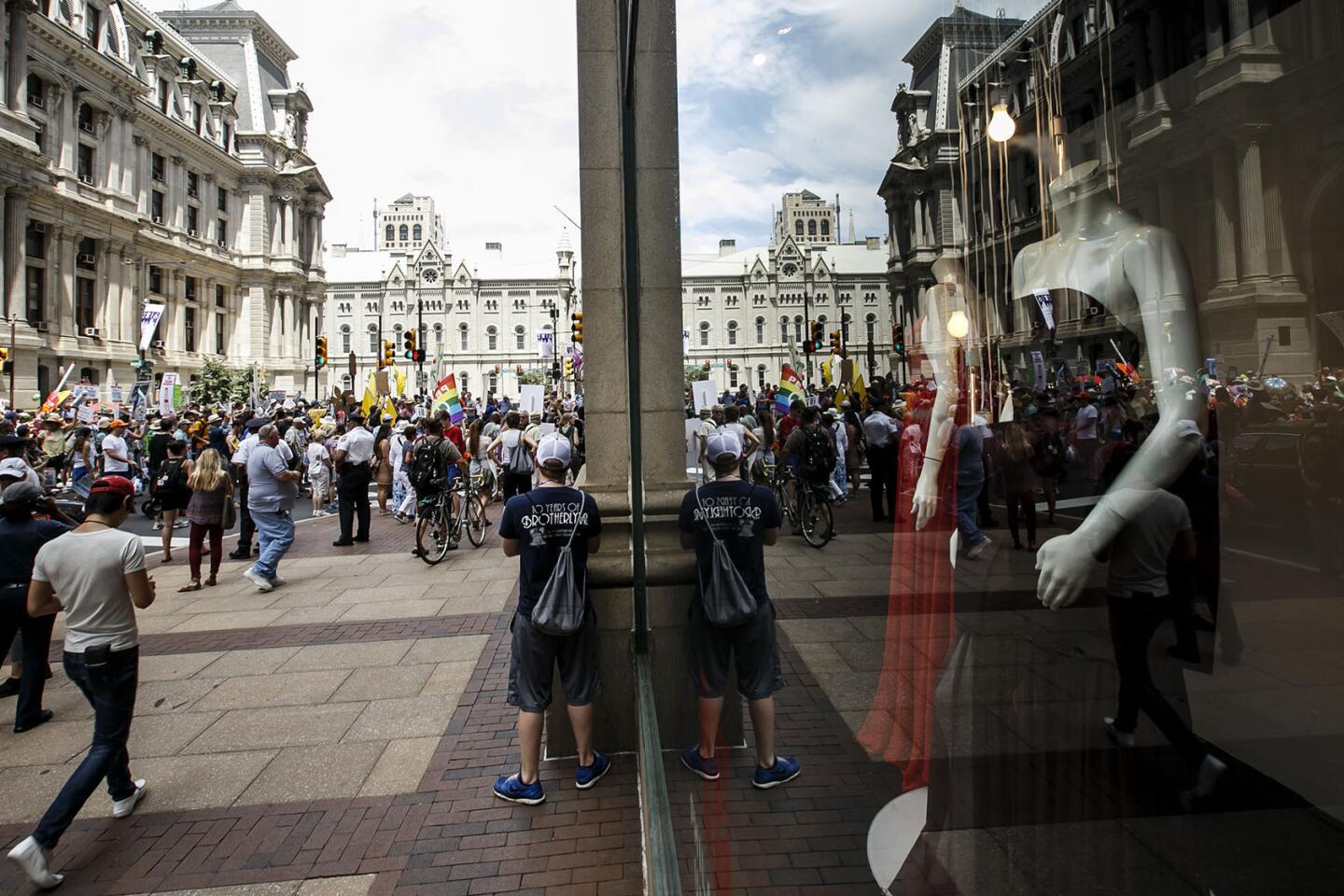What ‘great’ America are they talking about? A reporter’s journal outside the Democratic convention
- Share via
Stories from the streets outside the Democratic National Convention
Convention Eve: Feeling the Bern | Former Democrat | The march | Day 1: Expect turbulence | Lessons in civil disobedience | A polite protest | Day 2: More civil than disobedient | 'A scary time' | Day 3: Principles | 'Too many people'
Watch the convention livestream »
‘Too many people. I’m sick of the whole thing.’
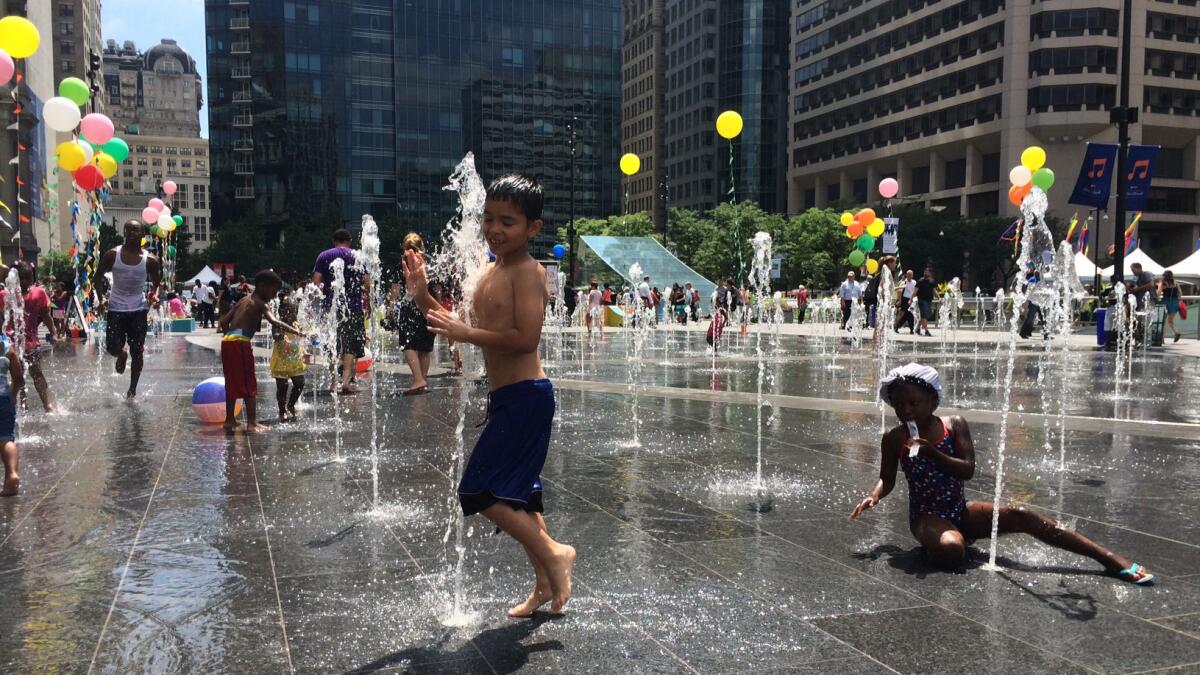
DAY 3, 3:57 p.m.: It's a pretty weird week to be a regular Philadelphian.
Sleekly dressed delegates to the Democratic National Convention pour in and out of the hotels around the Center City. Polite mobs of thousands of pro-Bernie Sanders protesters roam the streets calling for revolution. Along Broad Street, residents relax on their stoops as police block off the roads whenever a march is headed past.
"Too many people," said Dorcia Baxter, 34, who lives on Broad Street, and who was watching her young daughter play in the fountains by City Hall. "I'm just sick of the whole thing. I'm tired.... I can't leave my house to go anywhere."
Philadelphia is one of the nation's poorest big cities, and I asked Baxter what local issue is most on her mind. "I'm afraid of where our kid has to go to school," Baxter said. The local public schools have been struggling. And sometimes, she said, it feels like "crime is everywhere."
Philadelphians and the issues that matter to them have largely been lost in the sound and fury created by the tens of thousands of visitors who came to town for the convention. The Democratic delegates come from all over the country, as do the reporters, as do almost all of the protesters that I've talked to, and their interests naturally don’t focus too much on Philadelphia.
As I talked to Baxter, a band of revolutionary communists marched past, and yet another pro-Sanders rally swelled in the plaza across the street. Right here by City Hall, though, kids sprinted through fountains squirting water out of the ground, and health advocates were holding a day of planned physical activities for local children to make sure they get their exercise.
"You represent 26% of the population, but you represent 100% of the future," an emcee told a small group of dancing children, reminding them that they needed to protect their health and avoid smoking, and people who smoke. "One of you out there may be our future president.... Raise your hand if you have asthma!"
Once again, I noticed the subtle racial division that has run beneath seemingly everything on the streets all week. The local residents gathered around the public health event and the fountains outside City Hall were largely black — Philadelphia has large disparities in the general health of black and white children — while the Sanders activists who have been flooding their neighborhoods have largely been white.
Baxter didn't begrudge the Sanders supporters marching down her street; after all, some of the students at the private school where she worked had recently protested against police shootings, she said.
But I asked her if she knew how she planned to vote in November, and she immediately named the Democratic nominee, Hillary Clinton. "Oh, yeah," Baxter said. "I'm gonna vote for Hillary."
Nearby, I met Walter Johnson, 80, leaning against a fence and watching the kids running through the sprinklers. Some of Johnson's usual lunch friends decided to avoid Center City because of the convention, but Johnson, who is retired, wanted to come and see what all the fuss was about.
While we talked, I learned Johnson graduated from college with high marks in 1957, but had trouble finding a job because he was a young, educated black man before the civil rights movement's greatest victories. That's one of the things that irks him about Republican presidential contender Donald Trump.
"When he says 'make America great again,' what 'great' is he talking about?" Johnson wanted to know. "Was he talking about 1957, when I couldn't even get interviewed for a job? I think a lot of people are hearing that message. My father worked all of his life but wasn't in the union, because the union wouldn't accept him."
When he says 'make America great again,' what 'great' is he talking about? Was he talking about 1957, when I couldn't even get interviewed for a job?
— Walter Johnson, on GOP presidential candidate Donald Trump
Johnson counts himself fortunate. He began working in data processing in the early 1960s and got a job with IBM, which he held for 25 years. The house he bought in Philadelphia 45 years ago has now grown 40 times more valuable than when he bought it. Now his biggest problem is paying its rising property taxes on his fixed retirement income.
"My choice is what — move?" Johnson said. He says he is also worried about police brutality, and finding enough jobs for young people. When an apparently homeless man passed us and asked for change, Johnson added, "That's another thing I don't know the answer to."
A little later I talked to Clive Byfield, 63, who was passing through the square and paused to watch the children do their exercise routines in front of the sound stage. I asked him how he planned to vote in November.
"I think all Republicans and Democrats are the same…I'm not voting for nobody," Byfield said. "Hillary is a liar... I don't know about Trump. ... They are two of a kind, none better than the other."
The conventioneers will go home, he said. The political campaigns will spend all fall offering solutions, and then they’ll pack up, too. And Philadelphia will have the same problems it started with.
"There's always a promise," Byfield said. "Once they win, we don't see them after that." And with that, he waved goodbye, and we parted ways.
Principles have a price: ‘2000 wasn’t that long ago’
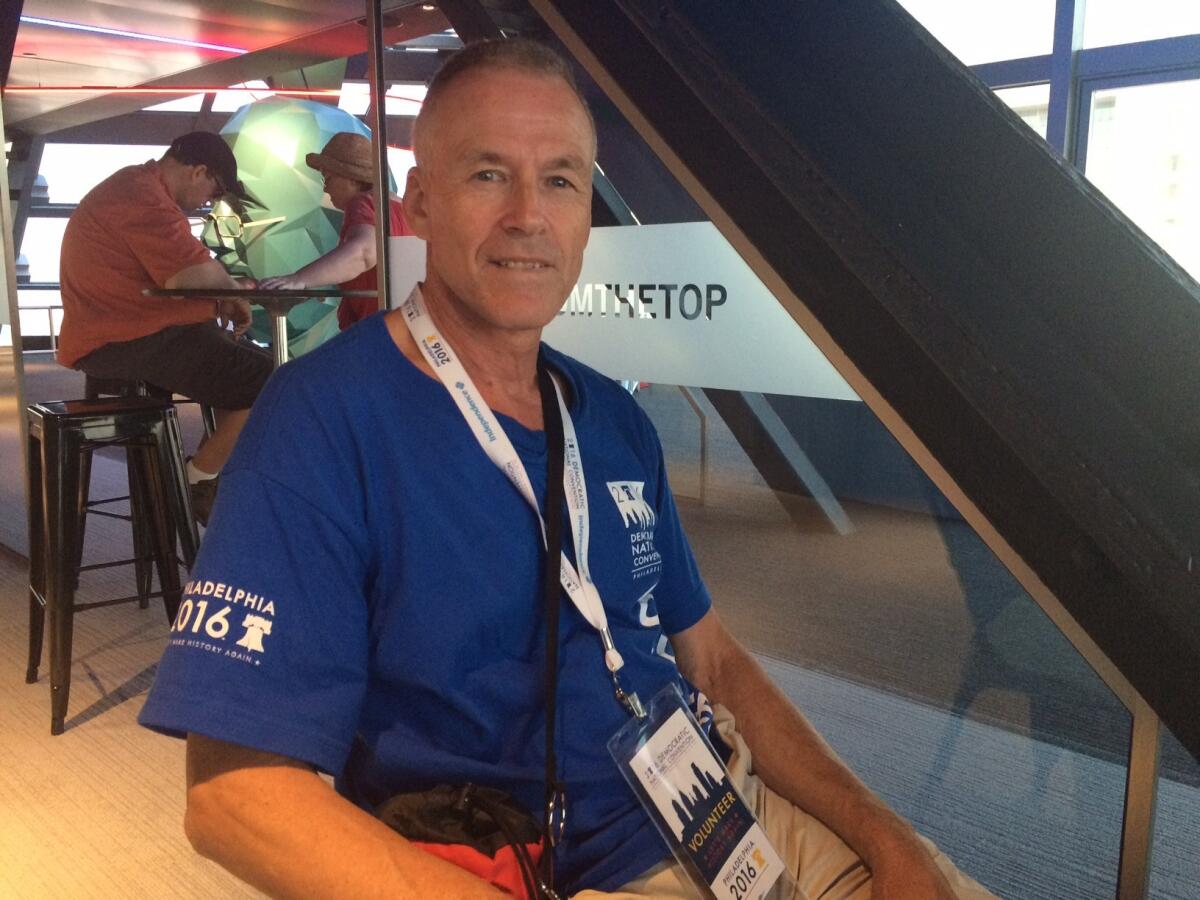
DAY 3, 12:27 p.m.: I scoured the streets of Philadelphia below through a telescope. I couldn't spot any protesters. Just the normal life, traffic and hustle of one of America's great cities.
For three days, I'd been stuck inside the bubble of protests that have surrounded the Democratic National Convention. Within that bubble, the view of the world is relatively narrow, and it goes like this: Hillary Clinton stole the primary election from Bernie Sanders; her nomination is a mistake; it's time to think about voting for the Green Party. On these issues, the protesters — who have numbered about 5,000 a day in the streets — have been remarkably consistent.
They also represent a minority view. It was time to venture out to get a look at things from a different angle, which is how I ended up on the observation deck on the 57th floor of the One Liberty building in Philadelphia's Center City.
From there, you can see just how big Philadelphia is: home to 1.5 million residents living across 134 square miles, who are equally white and black, heavily Democratic, and as of now, heavily likely to vote — in force — for Clinton come November.
While admiring Philly's horizons on the observation deck, I spotted a convention volunteer sitting quietly by himself, gazing toward Philadelphia's City Hall, where many of this week's protests have begun.
His name was Ron Lussier, 64, of San Diego, and he was a Sanders voter. When he's at home, he likes to run on the beach, and when he travels, he likes going up to skyscrapers' observation decks — to get a different perspective.
------------
FOR THE RECORD
9:10 a.m. July 28: In an earlier version of this story, a photo caption incorrectly gave Ron Lussier’s first name as Ben.
------------
An Clinton has her issues, Lussier told me, and he respects the protesters.
But, Lussier said, he will be voting for Clinton in November. No question.
It was all about the bigger picture.
"I think people who supported Bernie and are unwilling to support Hillary are doing a bit of disservice to the party and, I think, the nation," said Lussier, who got involved in volunteering for Democratic conventions after being disgusted by the George W. Bush administration. "The number of votes that go to another candidate" — such as the Green Party's Jill Stein — "could undermine a Democratic candidate like Ralph Nader did in 2000."
He pointed out all that hangs in the balance: Supreme Court nominees, control of the Senate.
"2000 wasn't that long ago," Lussier said. "I still remember what happened and the price we paid for it as a nation."
Lussier continued looking out at City Hall, which is topped by a statue of William Penn — known around Philly as Billy Penn — the founder of Pennsylvania. Lussier said he had just finished Ron Chernow's biography of American founding father Alexander Hamilton.
"Except for the 24-hour news cycle, the way politics is conducted has not changed that much," Lussier said with a smile, ticking off shenanigans with delegates and the peccadilloes of major political figures who are now memorialized in statues. "It's very familiar territory."
‘It’s a scary time for people of color like myself’
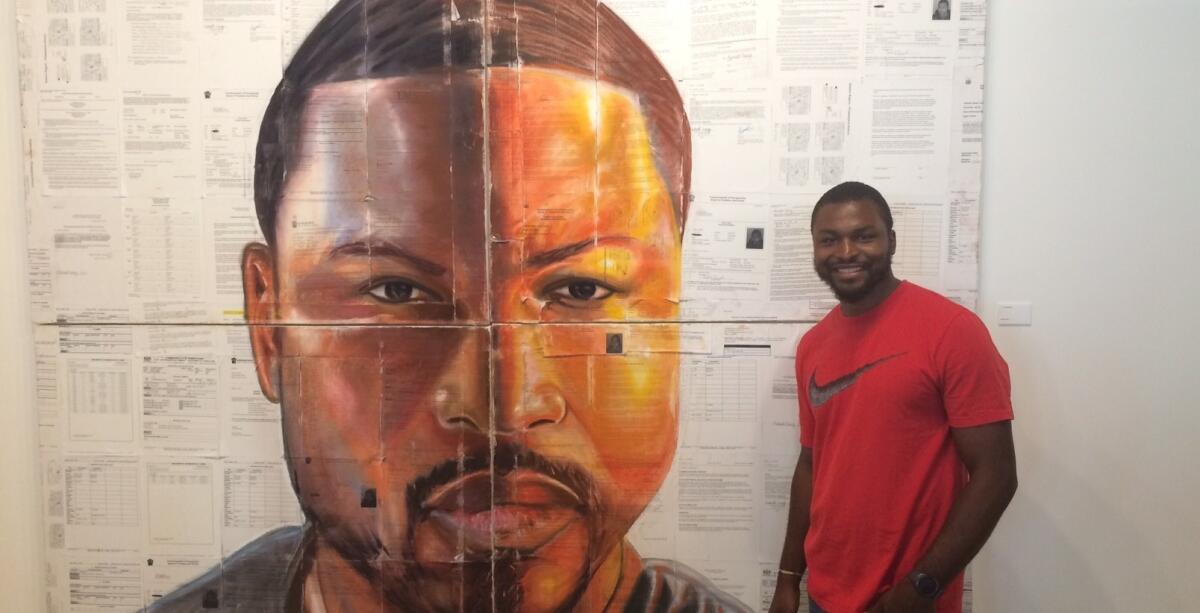
DAY 2, 1:48 p.m.: At last, air conditioning.
This week's pro-Bernie Sanders street protests in the insane heat had beaten me down, so I wandered into an event called "Truth to Power" where some of the powerful had come to speak.
The voting advocacy nonprofit Rock the Vote has sponsored a three-day pop-up event in a Philly art gallery, which was billed as a space for activists and artists "to elevate and illuminate the most pressing issues facing young people today." But compared to the rag-tag Sanders protest scene outside, it was a jolt.
Here be Democrats. Career ones.
When I walked in, CNN commentator and former Obama advisor Van Jones was interviewing Neera Tanden, president of the high-powered liberal Center for American Progress and a former Hillary Clinton advisor.
Shortly after, U.S. Sen. Cory Booker walked into the room. The New Jersey senator had been a favorite to be Clinton's vice-presidential pick, he’d addressed the Democratic National Convention just last night, and as he came in, the young audience came to their feet and pulled out their phones for photos.
For the last three days, the Sanders protesters had sucked me into their anti-establishment orbit, so maybe I was a little more sensitive to all the signals around me that screamed institutional support. The people were better-dressed; there was a professionally designed stage, professional lighting, professional audio equipment. And air conditioning
A racially diverse crowd had gathered for an hour of talks called "Will Criminal Justice Reform Ever Happen?" and there was nary a Sanders shirt to be seen. Still, the gravitational tug of the Sanders protesters could be felt in the room.
Booker, for instance, declined to criticize Sanders supporters for continuing to back their candidate, saying: "I don't want them to stop marching. I don't want them to stop yelling ... The problem is there are too many people on the sidelines."
Another speaker, U.S. Rep. Keith Ellison (D-Minn.), a former Sanders supporter, was a little more blunt on the pragmatic necessity of backing Clinton, who had earned stronger support from black voters than Sanders did in the primaries.
"The Ku Klux Klan thinks Donald Trump would be an awesome president," Ellison, who is black, said in recounting his own family's encounters with racism. "To say, 'Oh, I'm not scared of Donald Trump. I'm willing to risk Donald Trump being president' ... What a lap of luxury you must be living in."
I wandered over to an attached art gallery showing highly Instagrammable, woke-as-hell protest art that reflected the concerns of the Black Lives Matter movement — the other populist insurgency that has pressured the Democrats.
One painting in the gallery called "The Talk" showed black parents talking to their son as a news bulletin crawled on a TV in the background with news that an officer who had shot an unarmed child would not face criminal charges.
Another installation showed more than 600 body tags hanging from the ceiling bearing the names of people who had been killed by police so far this year. "By the time this show closes, we estimate another 15 names will be added to the piece,” said an explanatory text on the wall.
One of the artists, Russell Craig, stood next to a massive self-portrait of his face on four canvases, painted over a backdrop of sentencing and parole papers from his conviction on drug charges almost a decade ago.
Craig, who is black, said the four canvases intersect on his face, "because the black man is the target" of mass incarceration. He told me he'd turned to art in prison to try to change his life for the better. While I was interviewing him, a woman handed Craig her card and said, "I work for the Philadelphia Museum of Art." Craig brightened.
I asked Craig what he thought about the election.
"I was, like, feeling Bernie. Now ... no comment," Craig said, laughing, and I thought back to what Ellison had said about Trump.
"It's pretty self-explanatory. You do some research. It's a scary time for people of color like myself." Craig said, as if in wonder. "It's like a movie."
More civil than disobedient
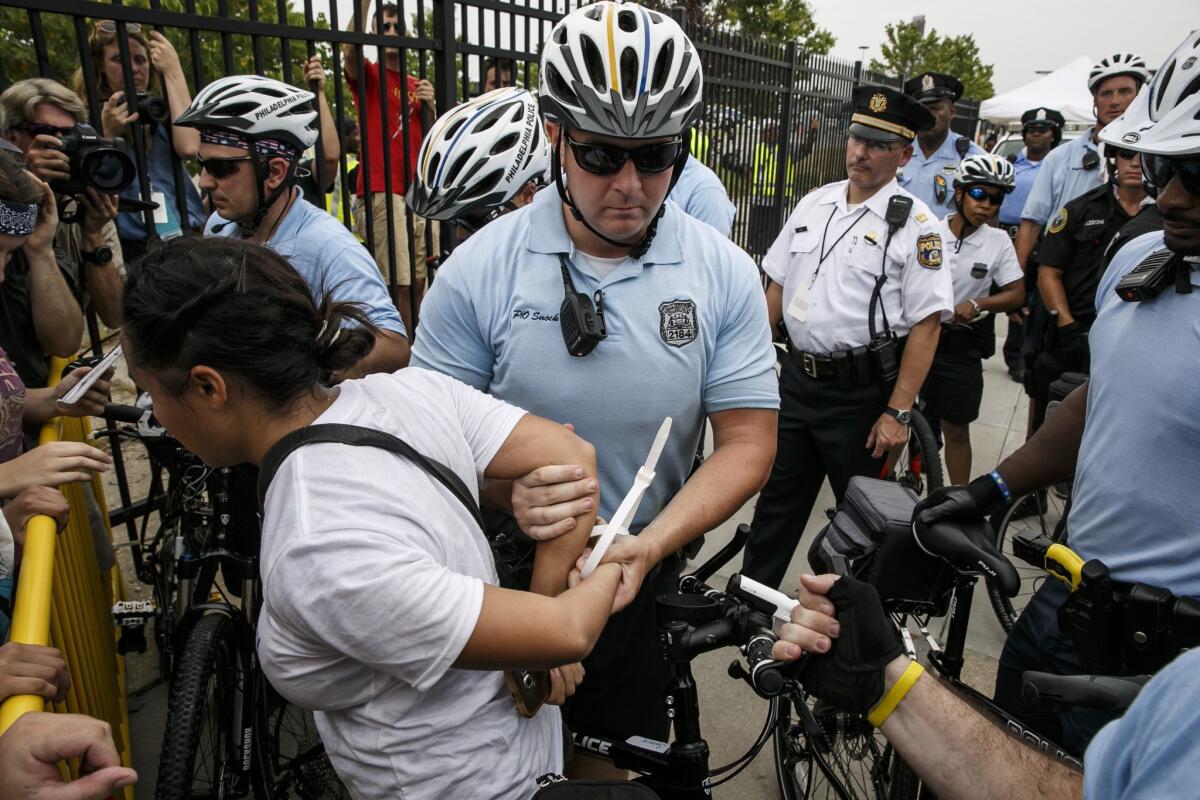
DAY 2, 8:33 a.m.: Last night, my campaign-trail paranoia flared up again as I walked back from the first night of the Democratic National Convention, with little else than a broken umbrella to shield me from the horizontal sheets of rain suddenly blasting the streets of Philly.
Thankfully, the rain felt purifying. My clothes were already soaked with sweat from following Bernie Sanders protesters around for hours in blistering heat, so the walk gave me time to think about what felt like one of the weirdest demonstrations I had ever seen.
As the convention began, Sanders supporters led by the advocacy group Democracy Spring tried to rush the entrance of the Wells Fargo Center where Democratic delegates had gathered for the opening-night speeches. The Berniebarians at the gate initially breached a line of bicycle police, but police quickly recovered and planted metal barricades in front of the protesters. The protesters then began climbing over them, one by one, into the waiting arms of police.
It was a planned act of civil disobedience. But when I squeezed closer to where the demonstrators were climbing over, I couldn't help but notice that things looked more civil than disobedient.
The protesters were waiting their turns to go before gently shimmying over. I watched as one officer would check with a supervisor, and then beckon the next protester to come over, like a firefighter helping someone out of a tree. The protester would comply, climb over and then calmly wait for the zip ties to bind their wrists.
A video I tweeted of this process got a several hundred retweets and a lot of "what?" responses, particularly among Black Lives Matters supporters, some of whom noted a little ruefully that a lot of the Sanders protesters in my photos looked white — which, generally, they were.
Here's the other weird part: Ultimately, 55 protesters were arrested — except that even though they were zip-tied and led away, they weren't actually “arrested," according to Philadelphia Police Department.
It turns out this was the handiwork of Philadelphia City Council, which decriminalized low-level offenses in advance of the Democratic National Convention so that the city could avoid the mass arrests and lawsuits it bore at the 2000 Republican National Convention, where more than 400 people were arrested.
The problem for cities is that the nominating conventions are often heavily protested, which has sometime lead to mass arrests, which have led to pricey lawsuits when protesters allege civil-rights violations. (Fewer than 200 people were arrested for protesting the 2000 Democratic convention in Los Angeles, but police shot protesters with beanbags and rubber bullets, and the city ultimately paid $4.1 million in settlements.)
Philadelphia would rather avoid that. So what this all means is that the protesters arrested — er, cited — at last night's protest were issued fines of $50, which is cheaper than some parking violations here.
So although the protest made a lot of noise and gave us in the media some interesting photographs, it wasn't much of an inconvenience for anybody involved.
And when I got home sopping wet and turned on my laptop to see how things were going inside the Wells Fargo Center, I saw that Sanders' insurgents had been inside the gates all along. They were among the Democratic delegations, booing their leaders and their party from the convention floor.
Protesters storm the barricades, politely
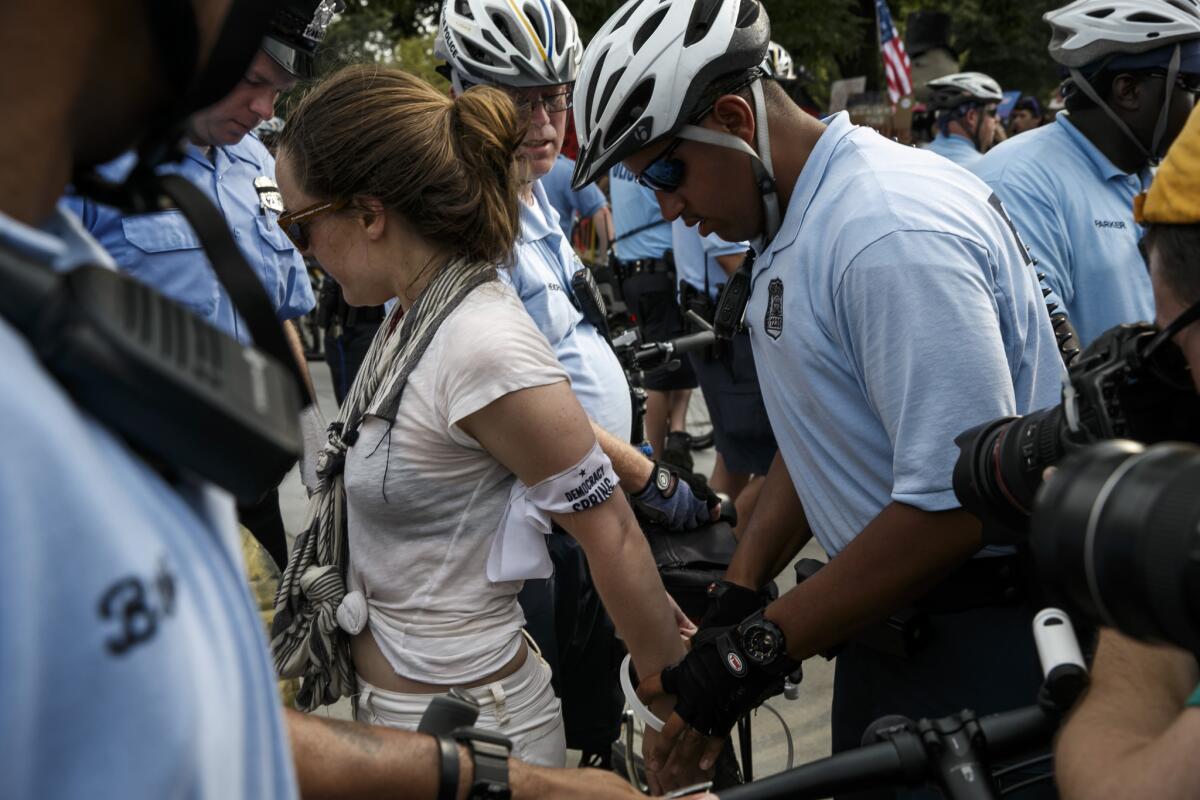
DAY 1, 5:53 p.m.: One by one, like passengers escaping a disabled airplane, a protester would step out of the crowd, carefully hop over the metal barricade and then politely and immediately get detained by the waiting police. Meanwhile, the crowd chanted, "Election fraud, election fraud, election fraud."
At one point, a whole crowd of protesters tried at the same time to hop over the waist-high metal barricades outside the Wells Fargo Center, where the Democratic National Convention is being held. But even that became orderly after a few seconds of frenzy.
"Whoa, whoa, whoa!" the cops said to one guy trying to hop the fence quickly. The protester stopped. "Wait your turn," a smiling officer said. "You'll get arrested." He did, and he was — at least for a while.
Bernie Sanders supporters tried to enter the secure perimeter around the conevention tonight, and police told me there have been 55 civil citations issued for disorderly conduct.
From where I'm sitting, I can see a police officer holding plastic zip ties like a bouquet. Hundreds more protesters stand outside the gates of the convention hall, calling for an end to the superdelegates system, the end of money in politics, and for the nomination of Sanders for president.
I had been following around several dozen protesters with Democracy Spring for a couple of hours, knowing they were planning to engage in some civil disobedience that might get them arrested.
They had come down Broad Street in the 93-degree heat. Protesters wore yellow or blue ribbons as clues to their roles — yellow for the marshals managing the crowd, light blue for the "tactical" team.
"Can we talk like this?" Desiree Kane, 34, of Denver asked me as we walked backward, side by side. She had a yellow ribbon, and so she was holding her arms out wide, like a rock singer about to fall backward into a crowd of her fans. She was trying to keep people from blocking the view of the enormous “DEMOCRACY SPRING” banner at the front of the crowd.
Walking backward, I asked her why she was marching.
"You can listen to the chants," Kane said.
So I did.
"Money ain't speech, corporations aren't people."
"One person, one vote."
"We want the billionaires out of politics," Kane said. Typing while walking, my phone auto-corrected "politics" to "platoons."
"At some point, asking over and over again — it goes nowhere," Kane told me. So "we're going to rush up on the steps of the DNC and crash the party."
The Democracy Spring protesters caught the police guarding the perimeter of the Wells Fargo Center by surprise at first, and they broke past a barrier some bicycle officers had created with their bikes. Then, singing the national anthem and "This Land Is Your Land," they sat down and watched the police place metal barricades in front of the crowd.
At that point, protesters started hopping over. Most weren’t really trying to get through the wall of police; it seemed they were just trying to get arrested and make a statement.
"I feel great! It's time!" Phil Jakobsberg, 53, of Silver Spring, Md., told me from beyond the barricade, where a police officer had handcuffed him with a zip tie. "People got to stand up and make change.... It's time for the people to take a stand on our corrupt election system."
And then, as they did with everyone else, the police took him away.
------------
FOR THE RECORD, 4:48 p.m.: An earlier version of this post reported that more than 50 protesters were arrested. In fact, they were briefly detained and issued civil citations.
Training for trouble, and other lessons in civil disobedience
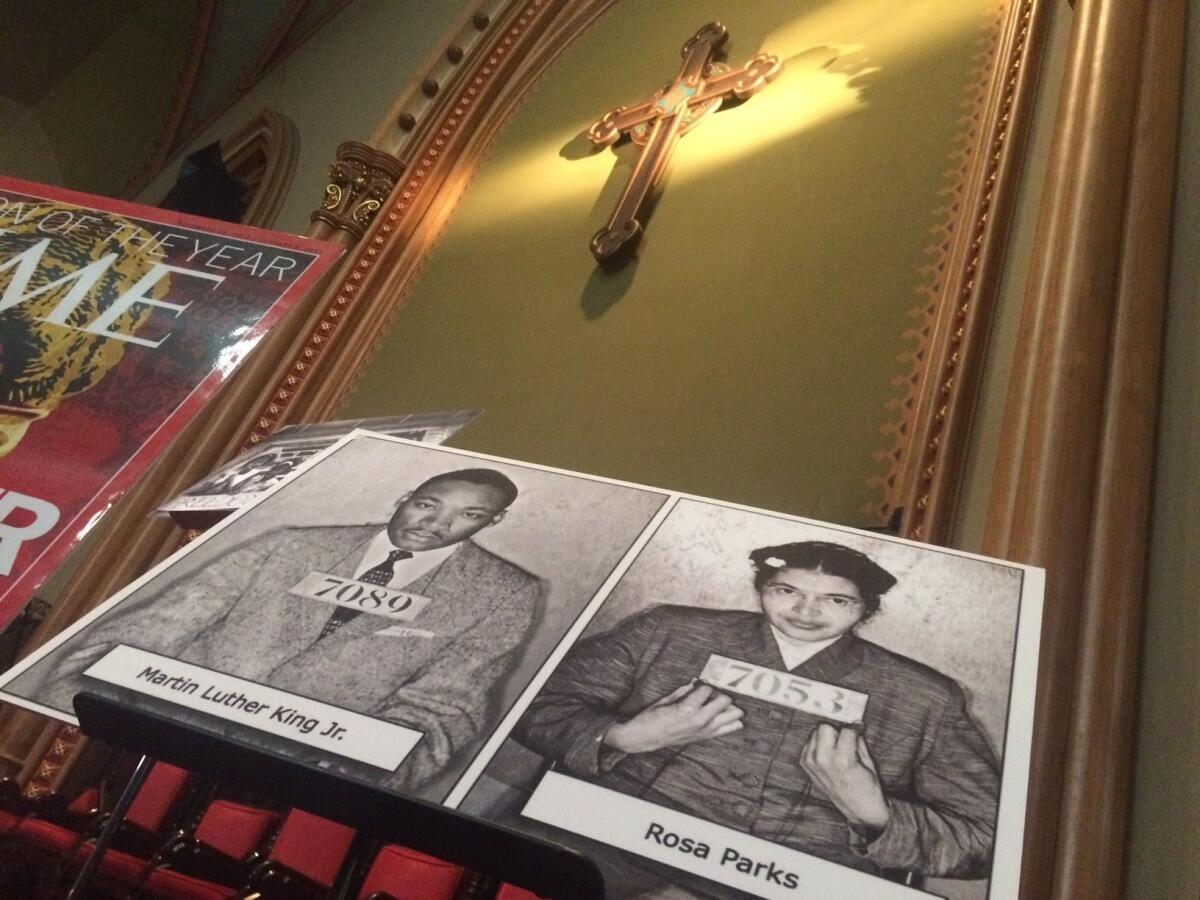
DAY 1, 11:25 a.m.: "Agents provocateurs," said the honey-voiced man standing before the altar. "What is an agent provocateur?"
At the Arch Street United Methodist Church near Philadelphia City Hall, activist groups from across the nation have gathered to commune, cool off and get ready for the Democratic National Convention to begin. This is the place where they have been training for the civil disobedience they promise is soon to come, and for the arrests that might follow.
When I walked into the sanctuary, members of a group called the Bernie PeaceKeepers were taking nonviolence training from Dion Lerman, 60. Police mugshots of Rosa Parks and Martin Luther King Jr. were propped on the altar behind them.
The goal of the training is to prevent or de-escalate violence. A projector beamed advice onto a screen: No violence, no weapons, don't get arrested, don't run, act collectively, "Serve the people gladly!" And look out for agents provacateurs, people from the opposition who might be lurking, quietly trying to start trouble.
"I've been doing this kind of training for 40 years," Lerman told me. "The Bernie people are really people of good will, with a lot of experience and a lot of passion about what they're trying to do."
The peacekeepers wore laminated lanyards around their necks that said, "Standing up together for Bernie's platform, I support his progressive ideas and ethics in a peaceful and positive way… Absolutely. #BeLikeBernie. 'I do NOT support violence of any kind.' "
That’s one ideology of many here at Arch Street United, where I also spotted a supporter of the Revolutionary Communist Party in the lobby, and kids with black bandanas who looked dressed to engage in black-bloc-style mayhem, if they wanted.
"This place is bursting with groups, from peacekeepers to anarchists," said Susan Britton-Seyler, a 66-year-old Quaker from Chester Springs, Pa.
Last night, the peacekeepers shared a training space at the church with the anarchists, which led to a little friction. "I got called a white supremacist," Britton-Seyler said with a shrug, noting that at the time, well, almost everybody in the room was white.
Britton-Seyler said she came to the Democratic National Convention to be "a different voice from all the people who are here to be angry protesters." And even though she was "Bernie or Bust" — the left-leaning equivalent of "Never Trump" — she and her group were single-minded about being peacekeepers."
But it was time to go; the peacekeepers' time slot in the chapel had ended.
As the peacekeepers left, another activist group, Juntos, spilled into the room in green shirts that said "Si Se Puede," (“Yes, We Can”) fresh off a march calling for immigration reform. As they collapsed on the pews to escape the screaming heat, they placed large photos of Latinos and signs that said "DISMANTLE ICE" — an apparent reference to Immigration and Customs Enforcement — at the foot of the altar.
They had the look, lined up there, of offerings to a higher power.
Expect turbulence
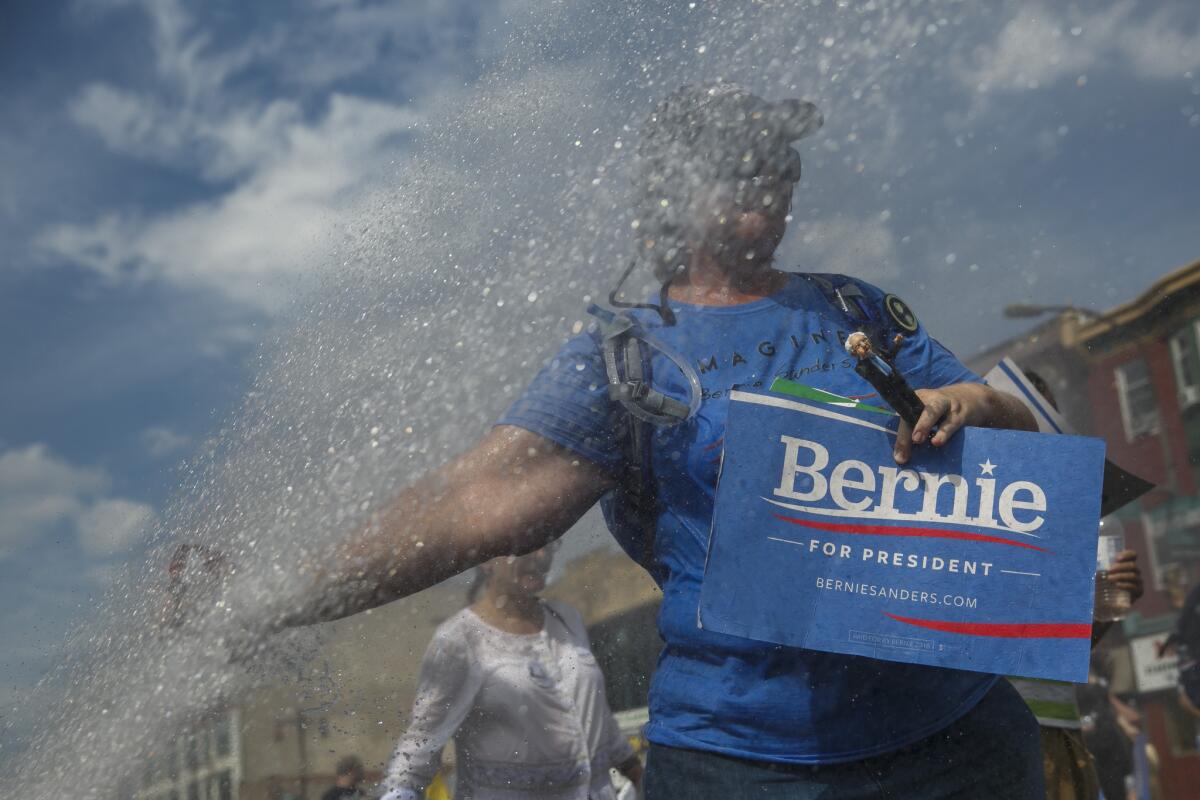
DAY 1, 6:23 a.m.: You might be seeing pictures of people in handcuffs soon.
The Democratic National Convention is going to hit some in-flight turbulence in Philadelphia. I can already tell. This morning, I'm staring at a full calendar of protests that includes training sessions for civil disobedience.
One popular grassroots organizing site, Democracy Spring, is asking visitors to sign up if they're willing to get arrested with "hundreds" of others this week to protest "to end the corruption of big money in politics and ensure free and fair elections." "We the People must nonviolently disrupt business-as-usual until we have a democracy that works for all."
Last week's Republican National Convention in Cleveland was, depending on your perspective, either a police state or a model of control. You had a small bunch of communists and Christian fundamentalists running around Cleveland yelling at each other while thousands of police officers played moderator, sort of like a heavily militarized debate camp.
It's worth reflecting for a moment on why Cleveland didn't yield the election riots that the press corps had feared for months. It's not like those fears came out of nowhere. I covered a couple of Donald Trump rallies in Southern California that ended with crowds of protesters and police in the streets, with Latino teenagers brandishing Mexican flags and telling me they were afraid of a "civil war" if Trump got elected. Plus, lefty activists often protest the Republican conventions.
The activists and protesters simply didn't show up in Cleveland. Not in numbers, anyway.
But they're here in Philadelphia, which is easier to get to from the big Eastern cities, has more places to stay, and, probably most importantly, has Bernie Sanders. Sunday's left-leaning demonstrations — attended by thousands of people across the city, I'd guess — were already larger than anything that happened in Cleveland.
As if to underscore the point, two of the first protesters I met Sunday outside Philadelphia City Hall were from Youngstown, Ohio, about an hour's drive outside Cleveland. They had come to Philadelphia to protest the Democrats, but they had not driven down the road to Cleveland to protest Trump. Fear was a big factor, they said.
"To be honest, everything that I've seen at Donald Trump rallies, it's just a giant hatefest," said Ashley Vaughan, 24, who supports Green Party candidate Jill Stein. "I'd rather stay away from stuff like that," she said. Why go alone into the lion's den when she can come to, say, environmentalist rallies where protesters share her views?
"Cleveland was looking a little scary. They had fences up everywhere," said Brandon Gorcheff, 23, who lives in Youngstown but commutes to Cleveland for work. "At least I don't see people here walking around with guns," as open-carry advocates had done in Cleveland.
Plus Gorcheff, who thinks the primary process was slanted against Sanders, would rather be "fighting for what I believe in than fighting against people who are not going to listen to me," he said. "I felt my time was better used coming here."
The march from City Hall
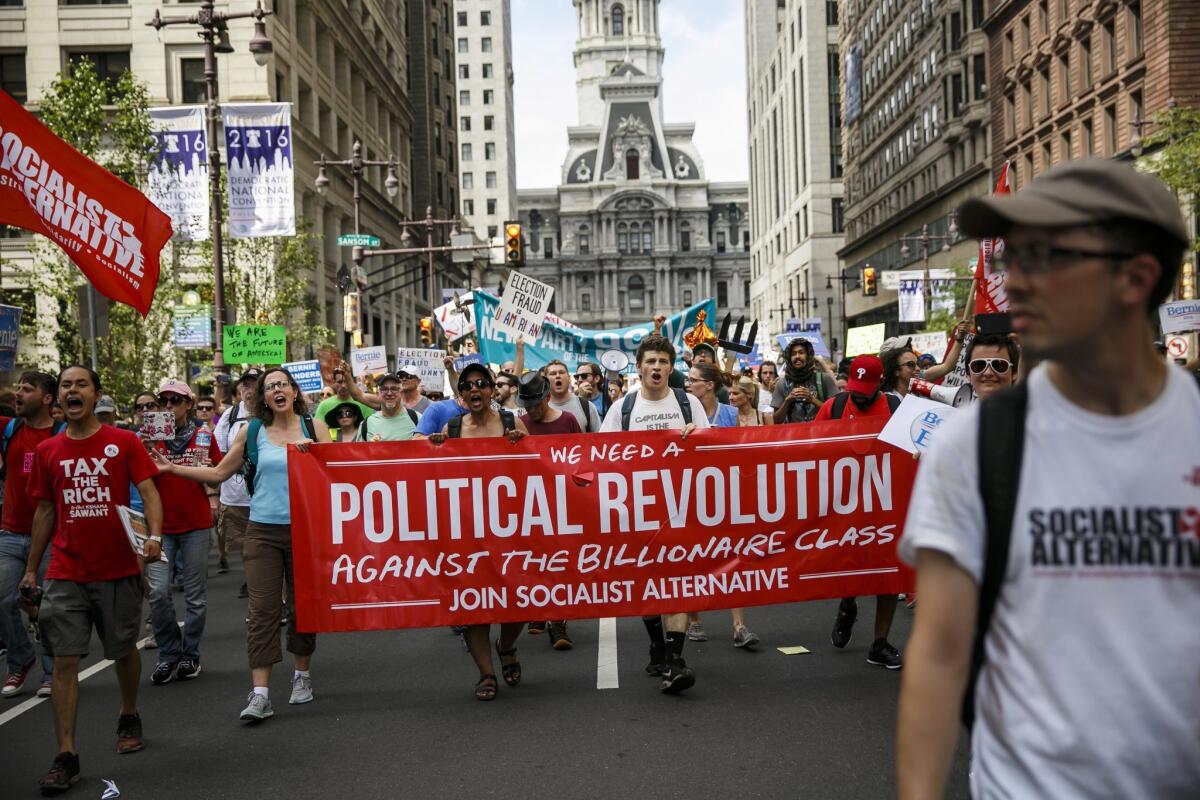
CONVENTION EVE, 4:06 p.m.: I'm typing this as I march down Broad Street, where the 97-degree heat is making my phone burn like a hot brick in my hand.
If anyone was wondering if the brutal heat forecast for Philadelphia would deter Bernie Sanders supporters from marching and rallying outside the Democratic National Convention this week, I can tell you the answer already appears to be no.
For almost an hour now, hundreds of pro-Sanders protesters (and possibly more, I can't even see the back of the crowd) have been parading — slowly — from City Hall toward the heart of the convention events in south Philadelphia. That's a distance of more than 3.5 miles, giving today's procession the flavor (to me) of a high-spirited death march.
Reporter's diary from the GOP convention »
Only a few onlookers were standing on the sidewalks outside as a "BernieVan 2016" led the proceedings, with chants issued through a huge Ghostbusters megaphone wielded by millennials on top of the vehicle.
"FEEL THE BERN! FEEL THE BERN! FEEL THE BERN!" the crowd shouted.
News of party chairwoman Debbie Wasserman Schultz's resignation over the Democratic National Committee email scandal brought a roar from the crowd: "DEBBIE! IS! GONE! DEBBIE! IS! GONE!"
"IN BERNIE..."
"...WE TRUST!"
"IN BERNIE..."
"...WE TRUST!"
Then a young man on top of the BernieVan 2016 started a new chant. "KILLARY IS NEXT!" he shouted.
"HILLARY IS NEXT!" the crowd replied, either accidentally or deliberately mishearing him.
I spotted a woman holding a sign that said "Talk the Talk, Walk the Walk, #FeelTheBern." I had just ducked into a gas station to buy two Gatorades after plowing through two bottles of water, and she was ready to walk and talk.
"I'm doing great," Emily Linder, 26, of Lynchburg, Va., said when I asked her how she was holding up. "It's a historic, remarkable moment to be a part of.”
How so, I asked? Was it Wasserman Schultz's resignation? No, Linder said. "For people to come together, it really is reminiscent of Martin Luther King's march."
Already, there had been the singing of what sounded like “We Shall Overcome” and chants of “Black Lives Matter,” even though the crowd was largely white. Now, the chant became: “We are the 99%.”
The march finally reached Franklin Delano Roosevelt Park, and I flopped onto the ground at the base of a tree, regretting my decision to wear jeans.
A single man began shouting at the entry to the park the way that victorious fans bellow after football games.
“No more Debbie!" he cheered. "No more Debbie! She quit!"
‘Another former Democrat.’ Philly is full of them
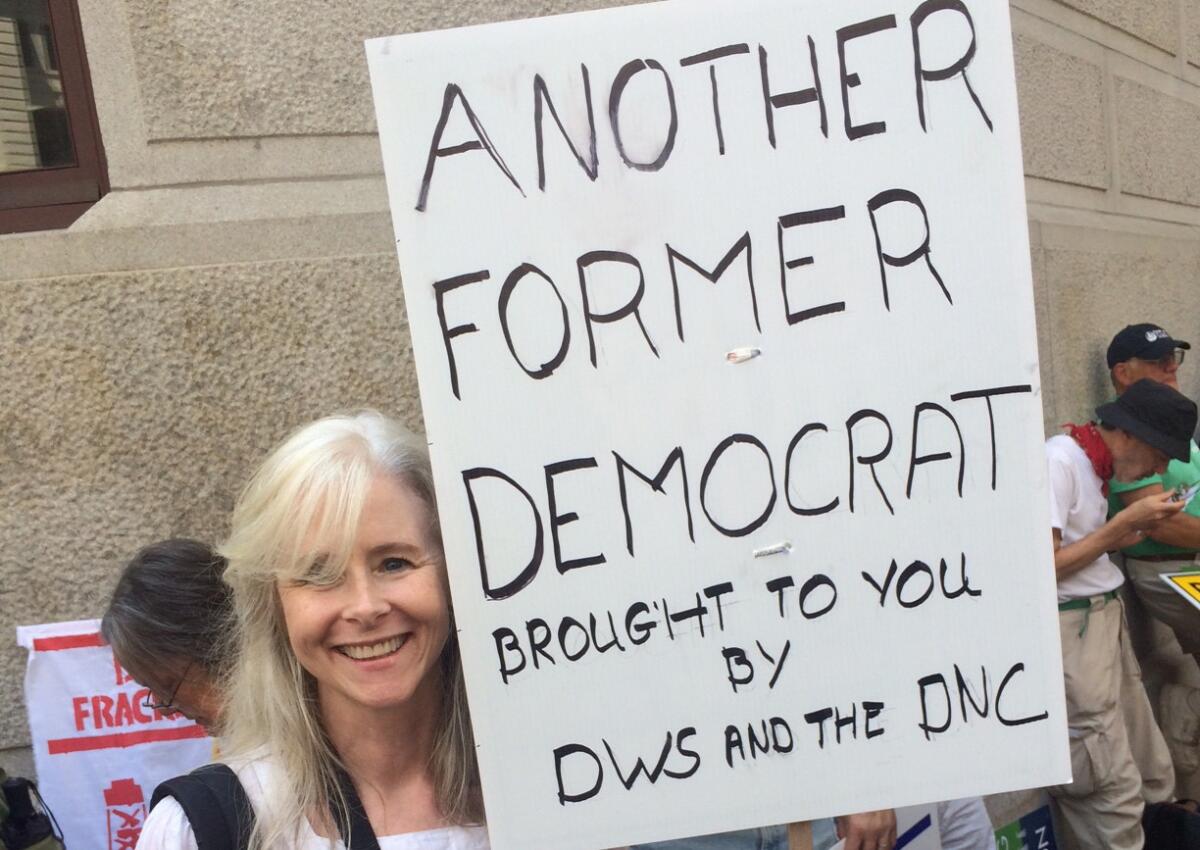
CONVENTION EVE, 2:28 p.m.: Rebecca Waring's sign said "ANOTHER FORMER DEMOCRAT brought to you by DWS and the DNC." The DWS stood for U.S. Rep. Debbie Wasserman Schultz of Florida. The DNC stood for the Wasserman Schultz-headed Democratic National Committee.
The recent leak of internal Democratic committee emails — apparently showing the supposedly neutral national committee's bias against Sanders — has already whipped up resentment among the Sanders supporters who are gathered around Philadelphia City Hall.
"I made this after I read the emails on WikiLeaks," Waring, 57, of Baltimore, told me. "I was just horrified. So unfair."
I saw another woman with a sign taped on her back that simply bore the words "WIKILEAKS" and "DNC," with the "DNC" crossed out.
Several of the Sanders supporters I spoke to already believed the primaries had been tilted against them — that there had been some kind shenanigans or outright fraud that skewed the vote toward Hillary Clinton.
The emails have now only hardened that view among some supporters who talked to me.
Kristy Marshall, 57, holding a sign reading "DNC: Destroying Nation's Confidence," said she'd already believed there's been "collusion between HRC [Hillary Rodham Clinton] and DNC." The emails posted on WikiLeaks, she said, were proof.
"To have it in black and white is — huh," Marshall said.
Still feeling the Bern in Philadelphia, at 95 degrees
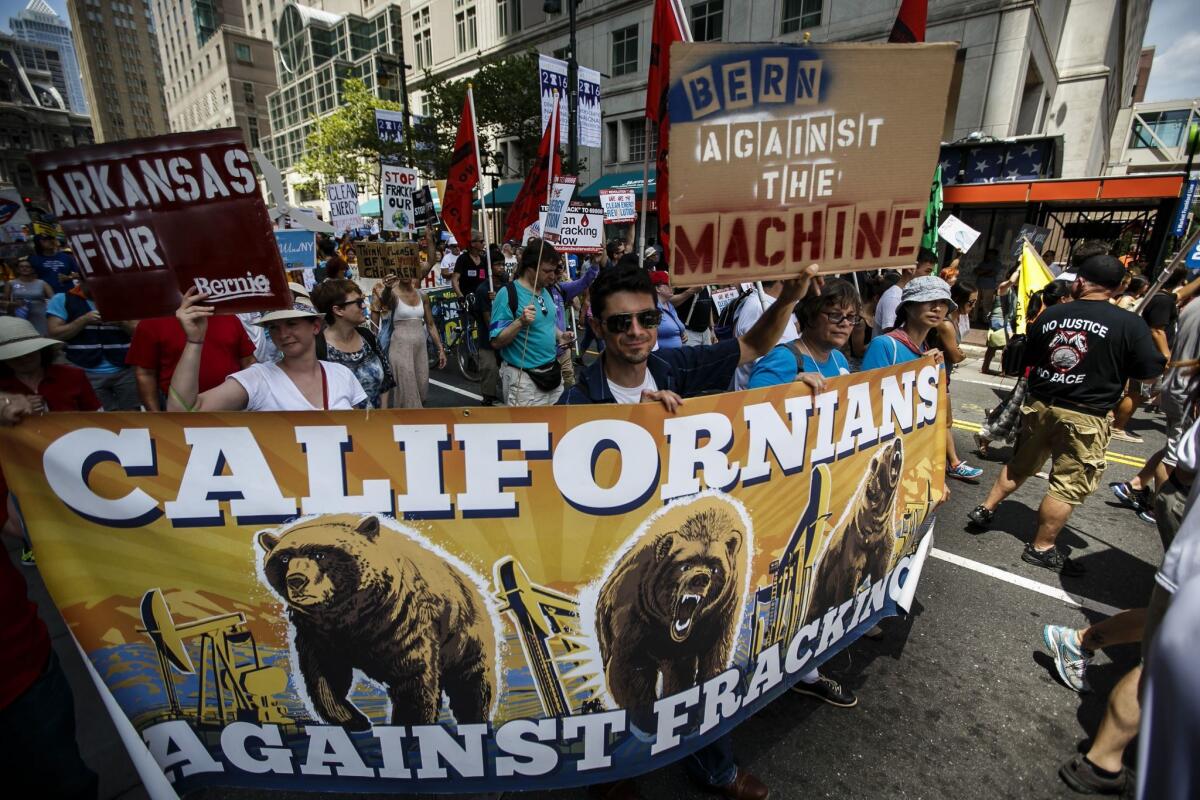
CONVENTION EVE, 12:55 p.m.: The drugstores in downtown Philly might want to stockpile more aspirin and deodorant.
If I have any prediction for how the Democratic National Convention will go when it starts tomorrow, all I can tell you is that it's going to be in the upper 90s all week and the Berniecrats plan to be out in force on the streets of Philly, protesting the party and agitating for a miracle.
It's 95 degrees right now, and I've already seen more protesters this morning in Philadelphia than I saw all last week in Cleveland for the Republican National Convention.
In fact, I've been wandering through a crowd of at least several hundred demonstrators who gathered around Philadelphia's City Hall for a climate activist rally, and I still have yet to see a single Hillary Clinton sign, button or T-shirt.
What I've seen instead, aside from the anti-fracking and anti-climate-change signs: Sanders shirts. Sanders buttons. A few Green Party shirts. A guy dressed in a rat suit and a sign that says "DemocRATS give rats a bad name," holding a giant pencil with its own small sign that says, "Write in Bernie."
And this was just the first of several rallies and marches planned. There's a "March For Bernie" planned near here in a couple hours.
SIGN UP for our free Essential Politics newsletter »
I moseyed over to a gentleman with a pro-Sanders sandwich-board setup and asked him what he thought about Hillary. "Who's Hillary?" responded Mark Kelderman, 60, of Brownsville, Wis., deadpan at first.
The race for the Democratic nomination is over in all but name only. But like many Sanders supporters I talked to this morning, Kelderman wants the superdelegates to vote for Sanders even though Sanders has endorsed Clinton.
"After I got done throwing up, I decided I would make my own vote of conscience come election time," he said. Not Clinton or Donald Trump. "At this point, maybe Jill Stein," the Green Party candidate.
I asked him what it would take to make him vote for Clinton. "A brain injury," Kelderman said. "I don't see it happening."
Follow @mattdpearce on Twitter
Reporter’s diary from the GOP convention
Get the L.A. Times Politics newsletter
Deeply reported insights into legislation, politics and policy from Sacramento, Washington and beyond. In your inbox twice per week.
You may occasionally receive promotional content from the Los Angeles Times.
